

‘Cake It Easy!’ gluten-free bakery opens in Logan
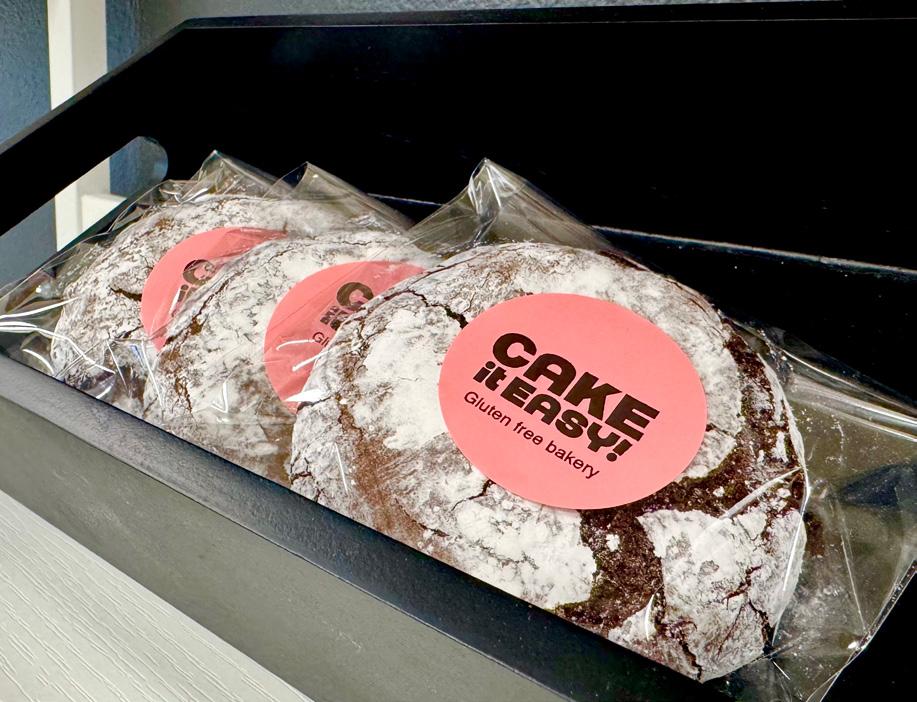
By Katie Smith STATESMAN REPORTER
“If you put in the work, it’ll get you where you want to go,” said Amy Fochs, co-owner of Cake It Easy!
Fochs and her sister Whitney Starks recently opened their new gluten-free bakery located on 1300 N. 200 E. in Logan.
For the sisters, baking has always been a large part of their lives.
“Our parents baked a lot, and when we got older, we would bake with them,” Starks said.
Their quest for creating tasty gluten-free baked goods started when their dad was diagnosed with celiac disease.
Fochs explained adjusting to this new challenge was a difficult process.
“He tried different recipes and bought all the flours and all the things,” she said.
Ultimately, the end result of the recipes was never as enjoyable as the ones with gluten, according to Fochs. “I’ve got to figure out how to make things good for him again,” Fochs said.
According to the sisters, this is partly where their journey began. They wanted to create an enjoyable experience for their customers also experiencing the same struggles as their dad.
“When you’re gluten-free, you don’t get a lot of options,” Fochs said. “We were talking about that and then kind of evolved into, ‘How cool would it be to be able to create your own?’”
In an attempt to liven up the gluten-free community’s baked goods options, Fochs and Starks said they created a personalized system to give their gluten-free customers the chance to choose for themselves.
“Up at the counter, it is a create-your-own. You can do a cake slice or cupcake and pick your frosting and put toppings, and everything’s gluten-free,” Fochs said.
The sisters said their favorite part of running this bakery is getting to meet other people also looking for gluten-free desserts.
“Being able to talk with everybody and hear their stories — it’s been really fun,” Starks said. “And realize you’re not alone — other people are dealing with the same thing.”
According to Fochs, meeting so many new people in the gluten-free community has been very eye-opening as they’ve heard different experiences of their customers’ journeys. She said it wasn’t until one hears these stories that they can realize just how difficult some people’s experiences have been.
“It’s also been very eye-opening to see the different things that people have dealt with health-wise that have led them to finding out that they need to be glu -free,” Fochs said. ““It isn’t until you’ve heard it from someone that you’re like, ‘Wow. How did you deal with that?’”
The bakery aims to be as community oriented as possible.
“The goal was wanting people to really feel like it was kind of like an extension of family,” Starks said.
Within their own family, Fochs and Starks try to include everyone, from their own kids to their siblings, nieces and nephews.
“It would be so much fun to have it be a whole family thing,” Fochs said.
Starting a bakery together was not a new idea for Fochs and Starks. According to the sisters, this was a lifetime dream of theirs: working together doing something they both love.
“Growing up, we always joked about having a family bakery,” Fochs said. “We will never give up on that.”
When the pair first started to look at Logan as a possible location for Cake It Easy!, Fochs said,
“Everything just sort of fell into place to be here.”
Starks said the hardest part of getting the bakery up and running was “just making the decision to do it and deciding that we’re doing it and committing to doing it.”
Fochs and Starks have many plans for the bakery’s future development. Fochs said they want to later add goods such as cheesecake, bread and cinnamon rolls.
“We want to make sure that there’s options,” Fochs said.
Fochs’ advice for Aggies thinking of starting their own business is: Pursue your dreams. She said it’s important to love what you do. According to Fochs, after working in different environments, she’s found it’s ultimately worth it to go for what you want.
“It gets tough, it gets stressful, but if you put in the work, it’ll get you where you want to go,” Fochs said.
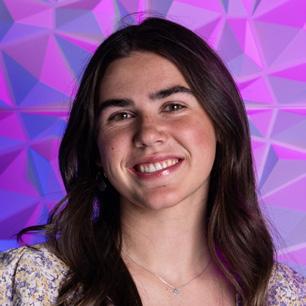
Katie Smith is a sophomore still exploring her options at Utah State. She is a big country music fan and loves spending her time in Cache Valley’s beautiful natural landscapes.
— katie.smith@usu.edu
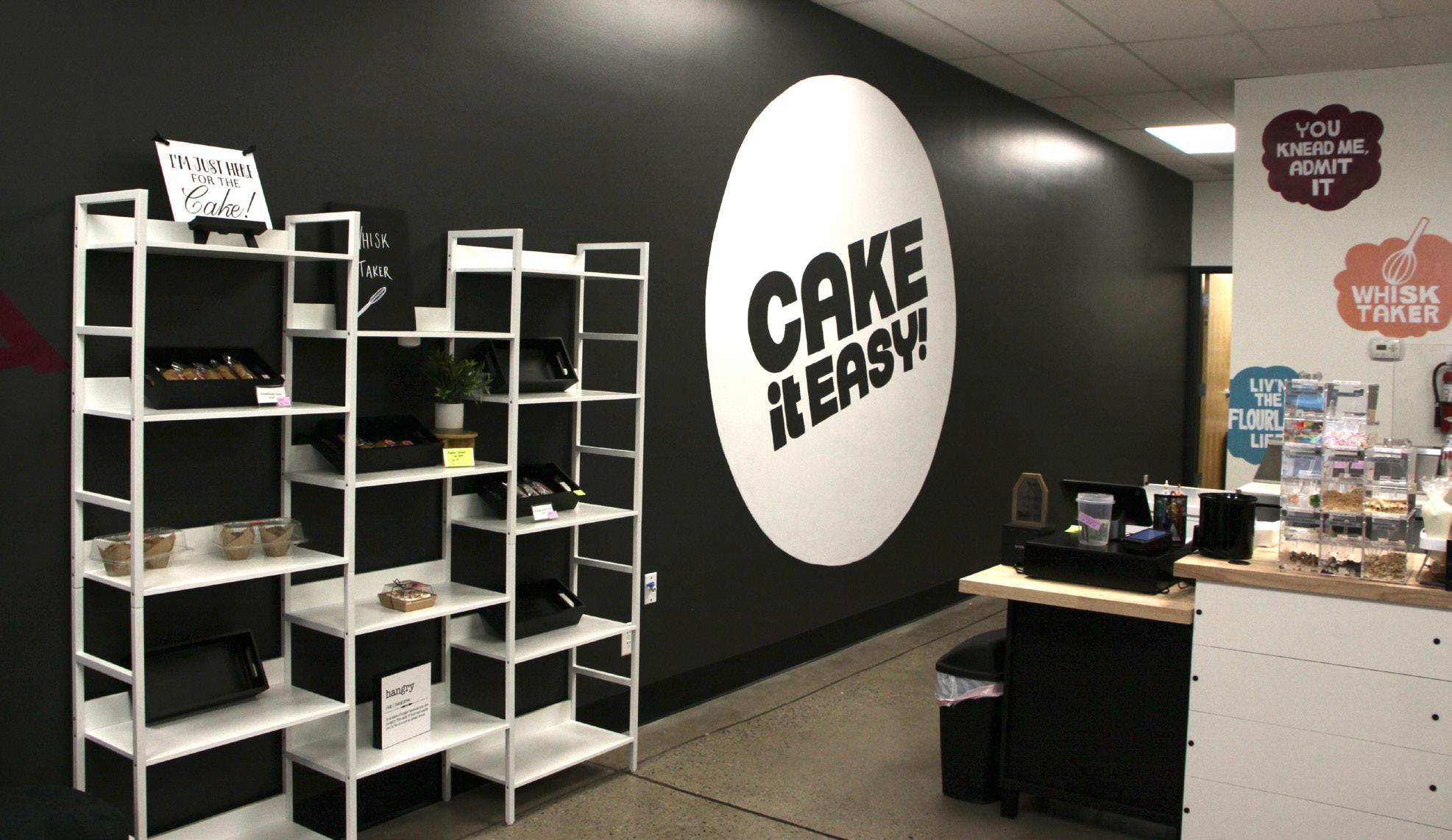
PHOTOS BY Hadley Sintay Chocolate cookies for sale at Cake it Easy!, as seen on Sept. 24.

Long-time professor recognized by national design organization
By Katie Smith STATESMAN REPORTER
When interior design professor Darrin Brooks was inducted into the American Society of Interior Designers’ College of Fellows, one of only four people in the nation honored this year, he didn’t see it as a personal victory. For him, the recognition was proof of what his students already know: Utah State’s interior design program gives them the tools to make an impact far beyond the classroom.
Brooks has been an interior designer for over 30 years. He began his career in practice and was later recruited by Utah State to return as an educator.
“It became increasingly important to me to become involved in professional organizations,” Brooks said about joining ASID and starting a chapter on campus. Brooks said the chapter has expanded significantly over the years, becoming a central part of students’ experience in the program.
“Since that initial ASID student group, we’ve had over almost 900 student members since my time starting at USU over the last 24 years,” Brooks said. “And the exciting thing is, in the announcement that came out this week, you can see that all of our students and all of our faculty are members of this organization.”
The USU ASID chapter has earned more than $150,000 in scholarships and awards, building a reputation for excellence that puts students on the national radar, according to Brooks.
“I’m most proud of that. Through this organization, it’s opened up so many opportunities for our students. Our students are known for winning all sorts of competitions. We have a reputation. Our program is ranked eighth in the country for value, and we’re very proud of that. We’re the oldest accredited design program in Utah,” Brooks said.
Starting on Oct. 1, Brooks will step into the role of chair-elect, overseeing all of the organizations within ASID. For him, that leadership role isn’t just about advancing the profession — it’s about shining a spotlight on USU students.
“Our students have a tremendous work ethic,” Brooks said. “I’m a tough professor, but our students are tough
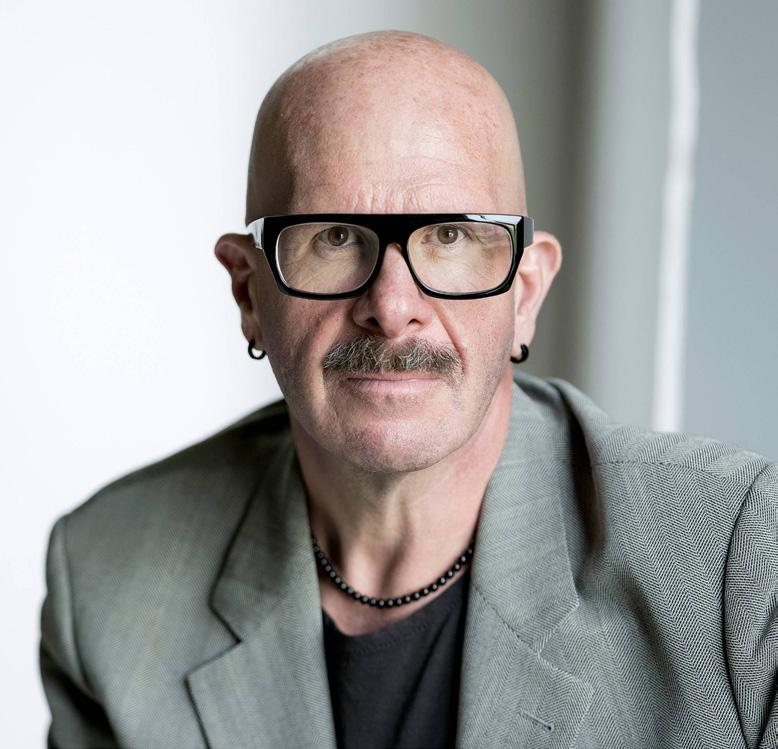
Brooks
because they work so hard. And what happens is that in that experience, they reach out. They want to hire our students.”
USU students learn skills and work habits that prepare them for careers in the industry.
“I love our program so much. It’s a wonderful blend of competitively pushing each other while also helping each other better our work,” said Ava Anderson, a USU interior architecture and design student.

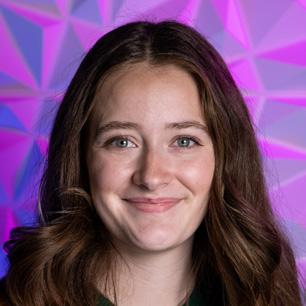
Jayke Martin is a junior studying journalism with a minor in theater. She loves reading and meeting new people.
— jayke.martin@usu.edu

PHOTOS BY Elise Gottling
The sign for the USU Interior Architecture and Design office, as seen on Sept. 24.
First-ever Huntsman Clothes Exchange kicks off Utah State’s Business Week
By Essence Barnes STATESMAN REPORTER
The Utah State University Jon M. Huntsman School of Business kicked off this year’s Business Week with an event focused on service, the Huntsman Clothes Exchange, where students could donate gently worn clothing to support those in need.
“We wanted to make sure that we were doing something meaningful and something that made a difference to someone’s life,” said J.J. Watts, the business school senator.
The Business Council was responsible for creating and coordinating the clothing drive. Together with the USU Christensen Office of Service & Sustainability, the council was able to get connected with the William A. Burnard Warming Center.
“We know that the winter months are particularly cold in Logan, and we wanted to partner with a local charity,” said Jason Duersch, director of professional development for the council.
The warming center works on providing overnight assistance to unhoused individuals in Logan during some of the coldest nights of the year by offering shelter, food and clothing.
According to Duersch, the drive was able to collect roughly 25 items of clothing. While he said they were
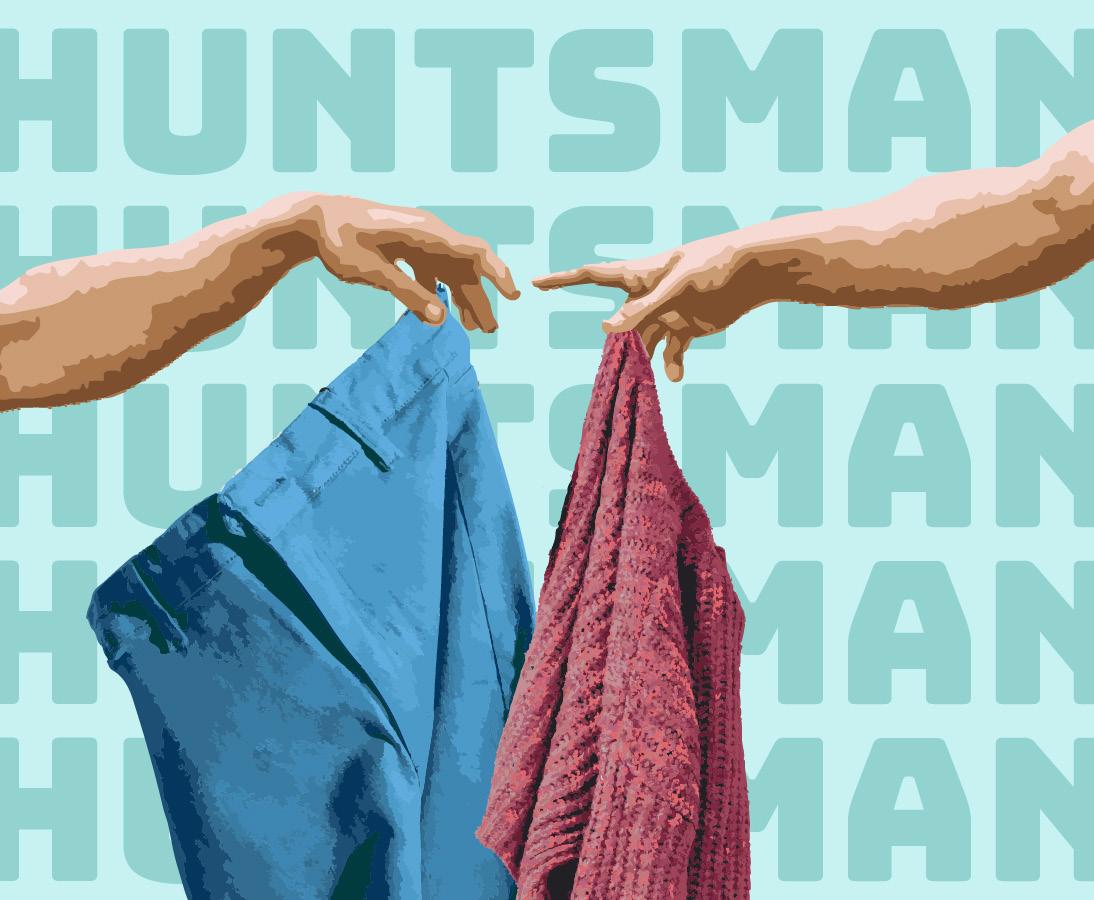
hoping for more donations, they were still grateful for what they were able to collect.
“I’m glad that we were able to connect with W.A.B.,” Watts said. “I’m happy with the way it turned out in that we were able to collaborate with them and that we made something happen.”
The clothing drop off box stayed open at Huntsman Hall for students and staff to continue donating throughout the rest of the week.
“It taught us we need to do better outreach for the event and maybe do a service project where more people can participate,” Watts said.
Watts and Duersch said the business school hopes to incorporate more service into their events in the future.


Essence Barnes is a thrid year journalism student who enjoys reading, writing and storytelling.
— essence.barnes@usu.edu
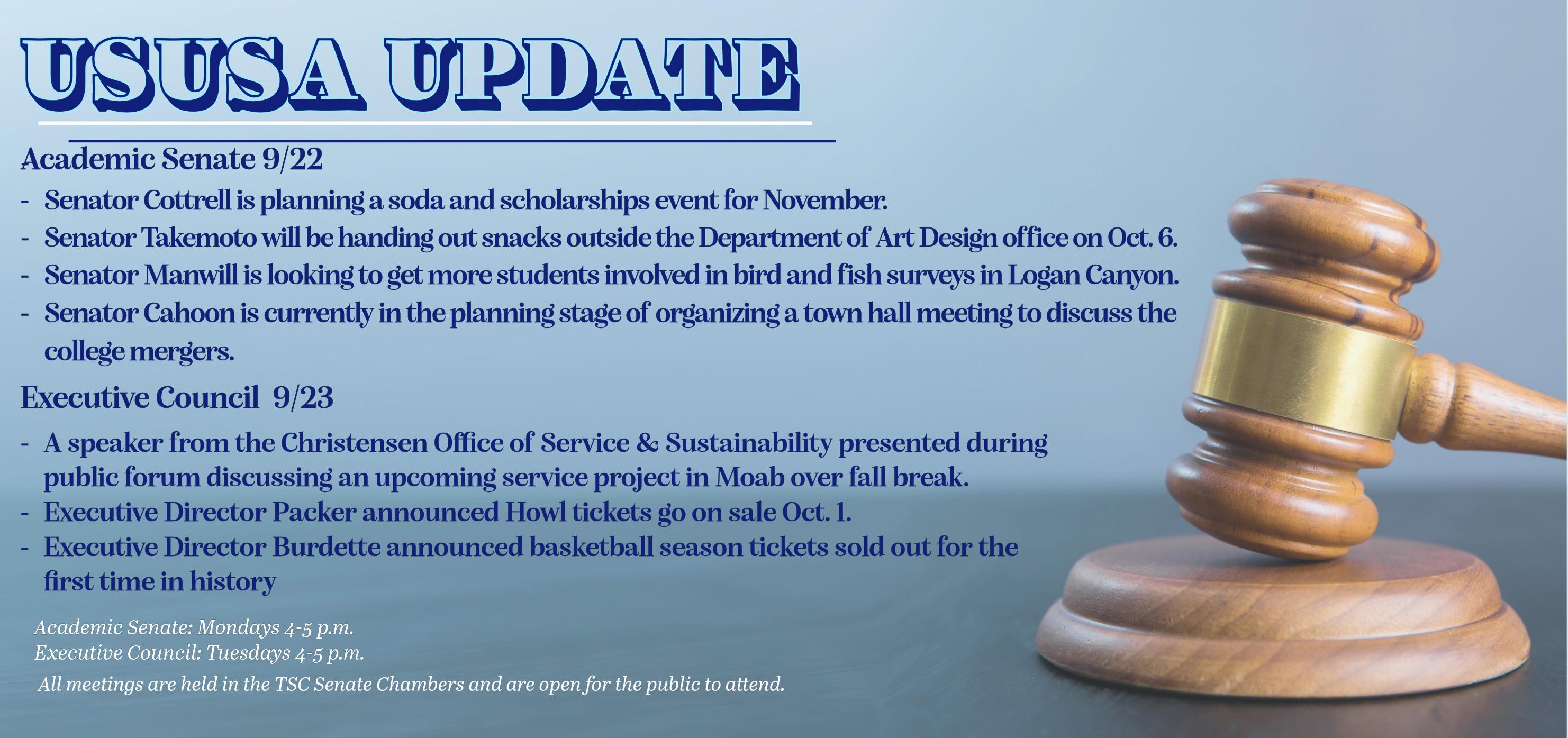
ARTWORK BY Kamrin McNeill
CUPID assists new Blind Date Club
By Emi Ludlow STATESMAN REPORTER
According to first-year student, Caleb Morgan, inspiration comes from the most unexpected places sometimes, such as in a Utah State University Connec tions course listening in on a random con versation. That is how Morgan got the idea for the USU Blind Date Club.
“A girl that was sitting in front of me — she mentioned, ‘I’ve never been on a blind date before’ ... and a girl behind me is like, ‘Oh, I know someone I could set you up with,’” Morgan said. “I’m like, ‘Blind date. Oh, this is a problem I could — blind date club. Oh, my goodness, it’d be great!’”
The club is now organized by six officers and a photographer. There are two com mittees: event planning and advertising. The event planning committee is in charge of the activities, reserving places, planning and getting supplies while the advertising committee works on online promotion through Instagram and inviting people. The schedule consists of a meeting the sec ond Friday of every month, and the fourth week is called blind date week.
“We release a form the week before, basically where you can sign up, put your name, information, times available during blind date week to go on a date, and there’s personality questions,” Mor gan said.
That information is put into a software that Morgan designed himself called CUPID: Computerized Utility for Pairing and Introductory Dating. This is where it takes the results from those forms and creates pairings based on personality and availability.
“I’ll send to each of those people say ing, ‘Hey, you’ve been matched. Meet up at whatever location at this time, this day, and we’ll give suggested date activities,’” Morgan said.
These activities range from food to school hosted events to pickleball. The goal is to not come back to club activities.
“Every club wants you to stay and never leave. This club’s like, ‘If you find your match, great. If you don’t, keep coming back,’” Morgan said. “It’s supposed to be low key and just trying to provide get[ting] to know people.”
First-year student Liam Markel, a new club member, went to the first club event: Casino Night.
“It’s nice connecting to people, and it’s fun playing cards,” Markel said.
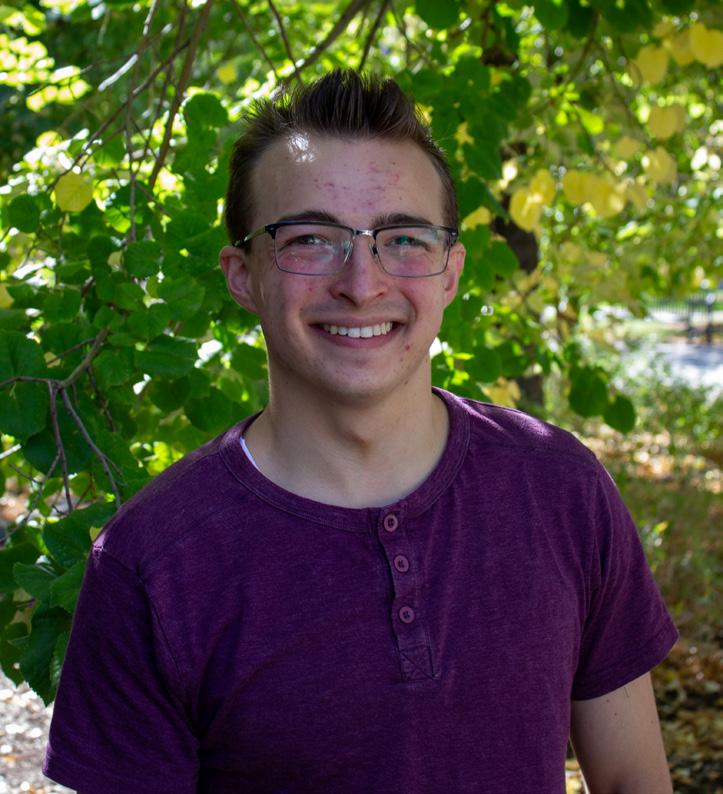
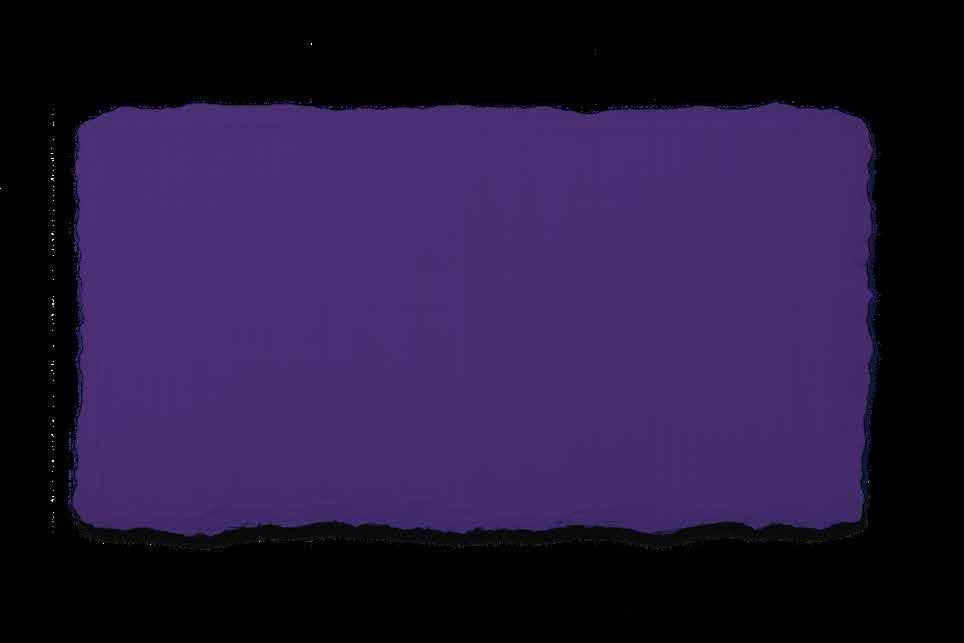

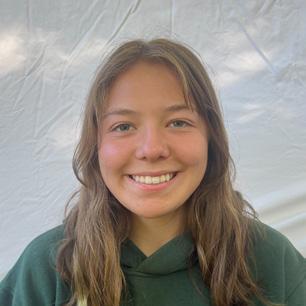
Emi is a first-year majoring in English with a hope to go into the journalism field. She has been involved in journalism for four years now, and her favorite part is telling people’s personal stories.
— a02474473@usu.edu

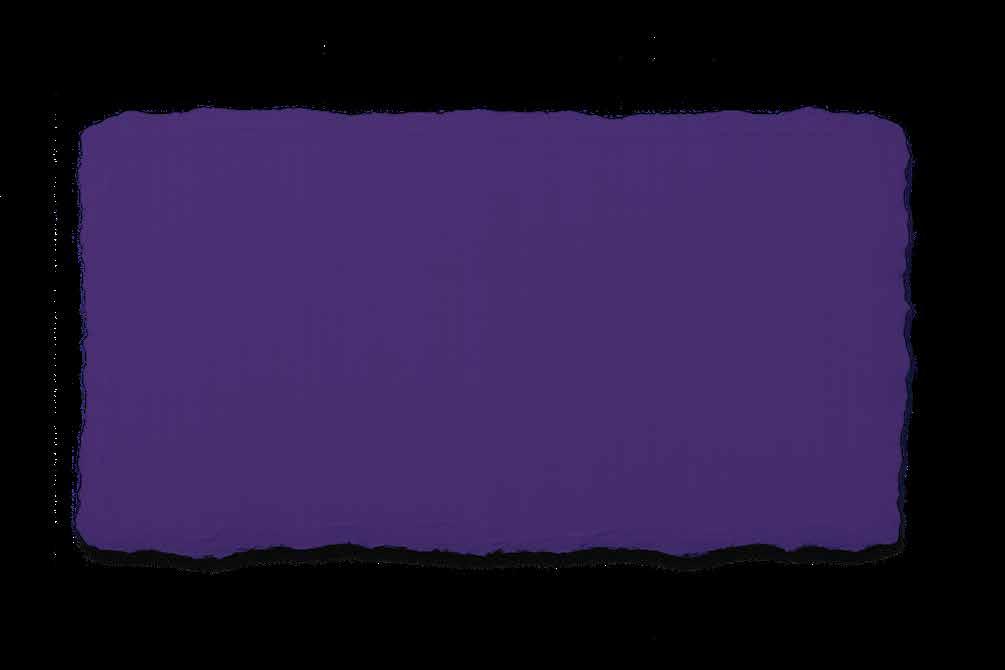

PHOTO BY Avery Truman
Blind Date Club founder Caleb Morgan stands for a headshot on Sept. 25.
Department of Theatre Arts performs modern-day ‘Dracula’
By Sam Isaacson STATESMAN SENIOR REPORTER
In its season-opening performance, the Utah State University Theatre Arts Department took the stage at the Morgan Theatre to present “Dracula, A Feminist Revenge Fantasy, Really.” by Kate Hamill on Sept. 26.
Loosely based on the “Dracula” novel by Bram Stoker, Hamill’s play explores the nature of predators while adding a modern feminist twist to the classic tale.
Paul Mitri, the play’s director, said they decided to go with Hamill’s version of “Dracula” to give the students an opportunity to perform something unique.
“This version is actually not that different, but the slant of it is more from the female gaze, which is really important,” Mitri said. “It’s hard for students to keep seeing scripts that are always about the female in distress and the men are the ones that are finding the solutions.”
One of the major differences seen in Hamill’s version of “Dracula” is the character of Van Helsing the vampire hunter being portrayed by a woman. Linn Eggett, who is the dramaturg for Dracula, said Van Helsing being a woman created a new dynamic between the vampire hunter and the other female characters.
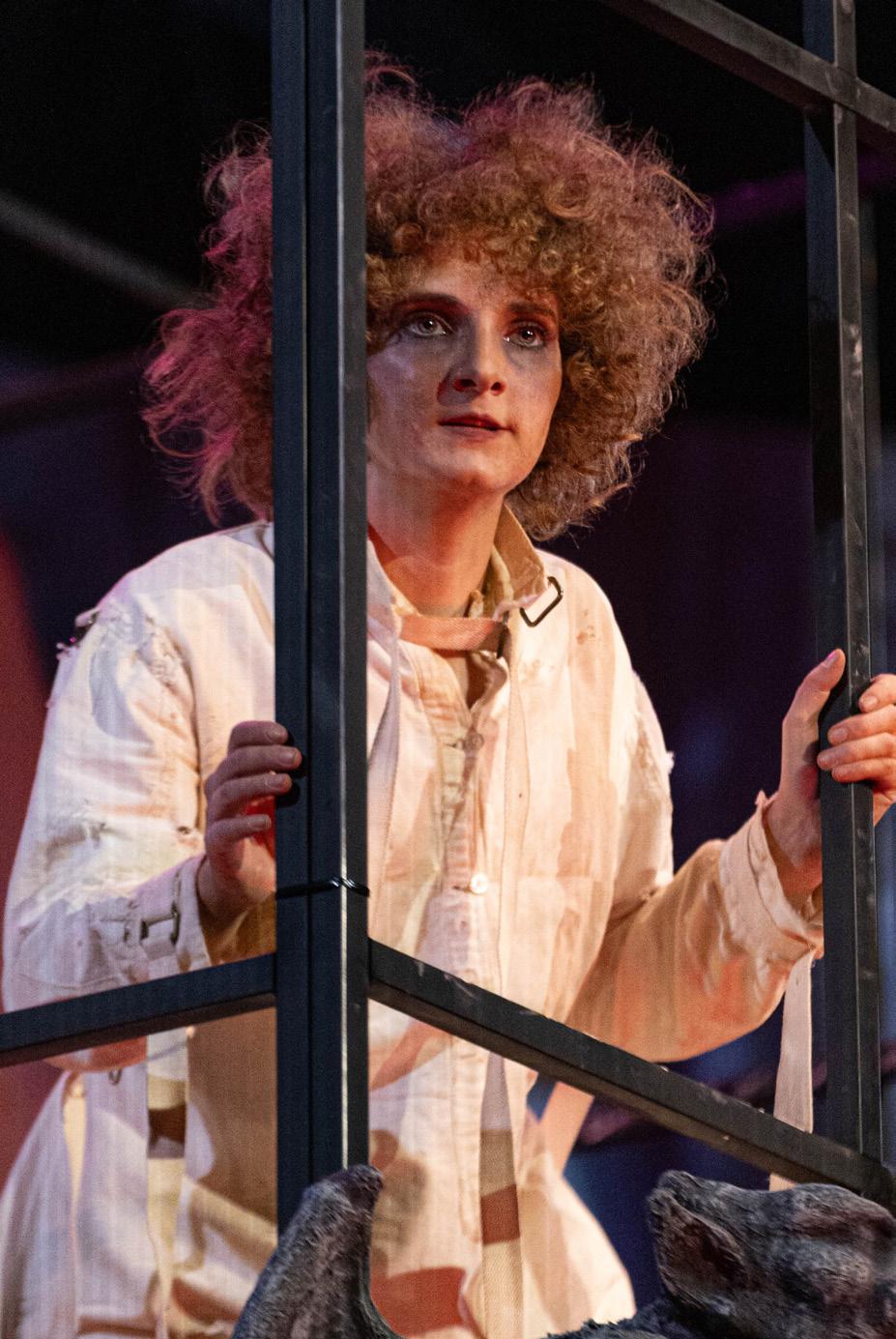
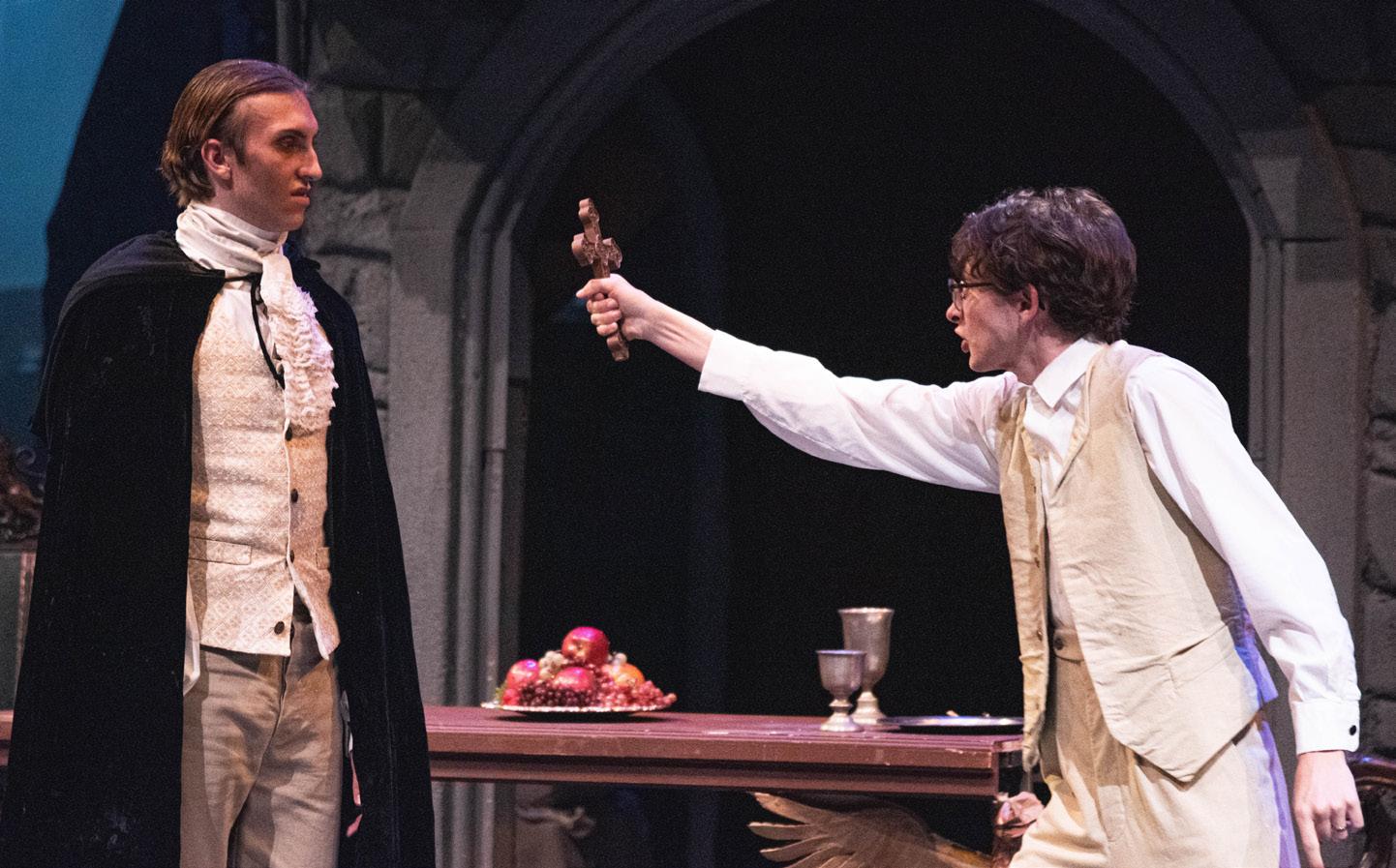
“The original Van Helsing is this mentor/father figure, and he presents himself as wanting to take care of these women,” Eggett said. “This oftentimes doesn’t do them justice because he’s looking at them as almost children. In this version, we see Van Helsing asking Mina what her opinion is on things — actively advocating for Mina to have a voice and for her to be listened to by men in the show.”
Riley Thompson, who plays Dracula, said this play’s female characters show how much harder women have to work to be treated equally.
“Right when Van Helsing enters in this play, it’s such a shock to everyone that this person with this big reputation, who is known for their intelligence, is a woman,” Thompson said. “It really showcases how women have to fight so much more just so they aren’t completely overlooked. In the play, every idea that the female characters have is kind of discarded, and in the end, their ideas and persistence resolve the entire issue in itself. I think it’s really important to recognize how this play showcases the idea that we need to listen more and have the confidence to persist with our ideas.”
In Hamill’s version, Dracula is still the main villain, but Eggett said he represents an issue much bigger than just one person.
“Hamill references the #MeToo movement from the mid2010s — specifically the Harvey Weinstein case — as being a big inspiration for how she wrote Dracula,” Eggett said. “It’s a normal thing for powerful men to be able to get whatever they want in this genre. Men in power use situations to manipulate women into being beholden to them. We see this idea through Dracula and see that it’s not unusual. He is not unique in the fact that he used his power to get everyone in his life to be beholden to him. There is this larger idea that he’s not a vampire. He’s just a man. He’s a man that you could meet in the streets. It’s
a man that could be your boss.”
Mitri said one of the major messages in the play is the idea that there are unnoticed dangers all around us.
“There are a lot of ideas that Kate Hamill is working with in this play, and one of them that we are trying to point out is this idea that there are monsters among us and it’s hard to tell the difference when they look just like us,” Mitri said. “When push comes to shove, are you going to be the hunted or the hunter?” Thompson said he feels the play empowers women to stand up for themselves.
“I think it is very empowering to women, specifically in that they hold so much more power than we give them credit for,” he said. “There’s a scene in ‘Dracula’ where our character Mina finally allows herself that freedom and independence and grants herself permission to access that power. She gives herself a voice and a say in what is actually happening.”
Mitri said it’s important more modern-based plays continue to be written in the future.
“For so many years, the playwrights, the directors and many of the characters have mainly been white cisgendered people, and while that’s certainly a slice of representation for the population, there are many, many other voices out there, and I think that we should make an effort to uplift all of them,” Mitri said.
USU theater will perform “Dracula” through Oct. 4. Those who wish to attend can find more information at artsci.usu.edu/theatre-arts/productions/dracula.

Samantha Isaacson is senior studying journalism with a double minor in art and psychology. She is passionate about human rights, animal rights and climate change.
— sam.isaacson@usu.edu
PHOTOS BY Jack Burton
Esther Barnes, playing Renfield, stares into the audience from behind bars at the Morgan Theatre on Sept. 25.
Riley Thompson, playing Dracula, and Nico Barlow, playing Jonathan Harker, face off, as seen at the Morgan Theatre on Sept 25.
Gallery Walk: Celebrating local art despite road closure
By Brook Wood STATESMAN REPORTER
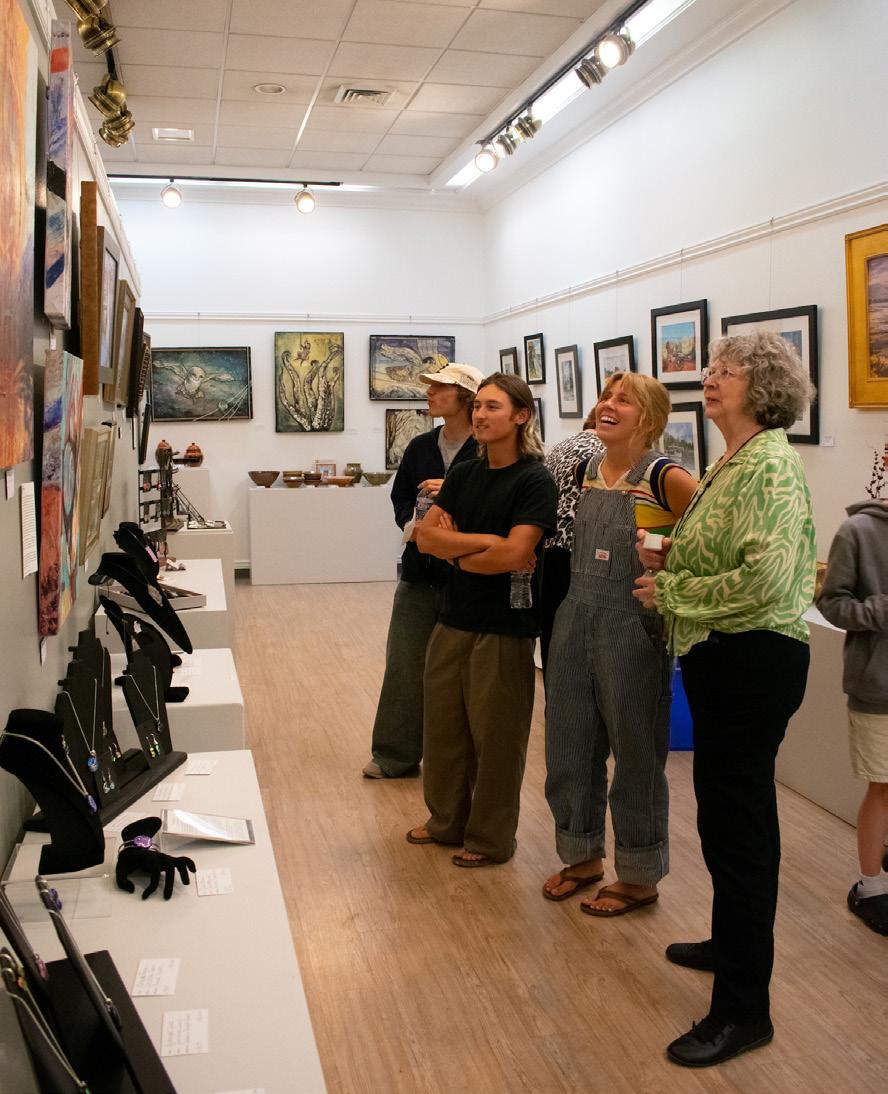
Four Fridays out of the year, from 6–9 p.m., the Gallery Walk in downtown Logan transforms businesses and galleries down Main Street into a celebration of local artists’ work. The most recent occurrence happened on Sept. 19 despite interference from street blockage for the Cytiva Top of Utah Marathon.
Tanner Stephenson is the owner of The Logan Gallery, the fine art gallery located on 115 S. Main Street that showcases local artists and musicians.
“The Gallery Walk is a way for local artists to be represented in the community,” Stephenson said. “It’s an opportunity to connect to the artists with buyers, and it’s also just an opportunity for talent to be showcased.”
The gallery looks forward to the event each of the four times it occurs, taking care preparing the storefront for the community building event, according to Stephenson.
“We got a pretty good attendance,” Stephenson said. “And we always invite all of our artists to come and talk with the patrons. We represent 35 artists, so for us, it’s just kind of like ‘Come and party with the artists.’”
Chelsea Funk and her daughter own The Alley on Center, another fine art gallery located on 19 W. Center Street.
“The Alley on Center Street has been a part of downtown Logan for four years,” Funk said. “Our motto is ‘purveyors of local art and talent.’ When we were given
the opportunity to showcase the art that’s already in The Alley through the Gallery Walk, it really excited us.”
The Alley still had good foot traffic during the walk despite the blockage, according to Funk.
“Logan City had shut down Center Street to get ready for the marathon, which we had no idea, which I thought was very, very distasteful on Logan City’s part, or Downtown Alliance, because they did shut down the road,” Funk said. “I mean, by all means, it didn’t hinder, but it also didn’t help.”
The Alley and the Logan Gallery featured local artists Tony Losee and Rodrigo Cortez, aka Roots, during the walk.
“Our main show, like our showstopper, is the Rodrigo Cortez room,” Stephenson said. “We have a whole room dedicated to his work. He’s got 28 paintings and a series of prints — they’re really good as far as technical proficiency.”
According to Funk, Losee’s phenomenal photography takes up the entire second floor of The Alley.
In addition to showcasing talented featured artists, the walk provides the opportunity for local artists to show their work without having to travel far, according to Funk.
“They have a place they can put it and not feel too nervous because it’s in their hometown,” Funk said. Stephenson emphasized a thriving art scene is a key indicator of a thriving community willing to embrace new ideas and actively strive to improve itself.
“Cultures even as small as Cache Valley, you know, they stagnate and become xenophobic and just kind of lose some of their life force, so events like the Gallery Walk or any public art program in general are just really critical for the culture of the community,” Stephenson said. “The tone of the culture of the community kind of predicts the long-term success of the community.”



Hi! I’m Chelsea, DJ of “Lights, Camera, Music!” I play film scores of a different theme on Thursdays every week at 2 p.m. on Aggie Radio 92.3 FM.
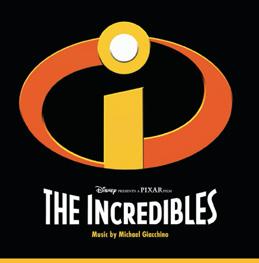

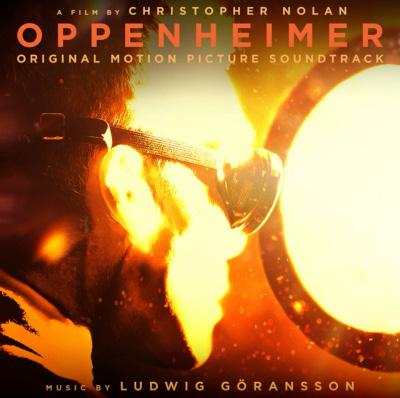
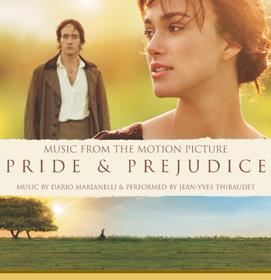
Brook Wood is working towards receiving a bachelor’s degree in literature. When they aren’t writing or reading, they enjoy playing the violin in the USU Symphony Orchestra.
— b.wood@usu.edu

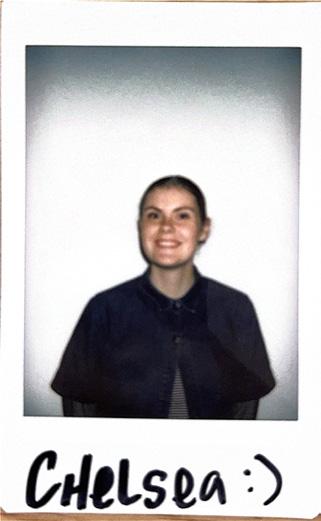






Life’s Incredible Again Michael Giacchino
Across the Stars
John Williams
Can You Hear the Music Ludwig Goransonn
Liz on Top of the World Dario Marionelli
The Big Race Randy Newman
PHOTO BY Elise Gottling
A group of people admire the art displayed during the Gallery Walk on Main Street on Sept. 19.
Squirrel picnic tables pop up around campus
By Dylan Moore STATESMAN REPORTER
This fall, Utah State University students have noticed something unusual tucked along walkways and near trees: tiny wooden picnic tables designed just for squirrels. Painted in Aggie Blue and topped with colorful umbrellas, the tables have quickly become a playful campus icon.
The tables, which seat no more than a squirrel or two, appeared quietly before the semester began. Over the weeks, students stumbled upon them stocked with peanuts, often pausing to take photos or share the discovery on social media.
Soon, the miniature furniture gained a following of its own through an Instagram account @ususquirrelsquad dedicated to their care and maintenance.
The creator of the squirrel tables, who asked to remain anonymous, said the idea started as a hobby project in their woodshop. What began as a single blue prototype soon became a set of four tables, each topped with an umbrella.
“I had been testing the blue prototype in a couple of different locations and finally gotten a squirrel to be enjoying the one near the ELSC,” the creator wrote in a message to The Utah Statesman. “When the students came back to campus for fall semester, I was really enjoying watching them find it.”
The lighthearted project took a turn when the first table suddenly disappeared.
“Then one day, the second week of school, I went out to fill the feeder and it was gone,” the creator wrote. This turn of events brought all sorts of people together
in an attempt to get the table back. Many students on social media and even the USU Campus Store helped to get the table returned.
The table did come back — the umbrella was slightly damaged but intact. Yet soon after, another went missing near the Quad, discouraging the creator who had hoped the tables would simply spread joy.
“I just don’t understand why anyone would just pick it up and walk off with it,” the creator wrote.
Whitney Boudrero, senior director of alumni engagement at USU, said she immediately saw potential for the tables to become a symbol of Aggie pride. She is a close friend of the project’s creator and suggested one key design feature: the Block A base.
“It just kind of hit me one day because this person is — has the most Aggie pride, always wearing navy blue. And it just really embodies that Aggie family spirit,” Boudrero said. “If you’re going to do these, I think they’re going to become an icon on campus. Could you do them with a Block A underneath?”
Boudrero said she has been encouraged to see students embrace the tables, even though the project is not an official university initiative.
“Anytime Aggies come up with ideas, I think some great things happen,” she said. “Sometimes, when students create things that are unofficial, others come along just because there’s not that pressure of it being an official organization or event.”
For her, the squirrel-sized furniture is more than a novelty.
“Following the dark times that have kind of happened in the news, it’s really been a bright little light on our campus that just brings a little spirit of joy,” Boudrero said.
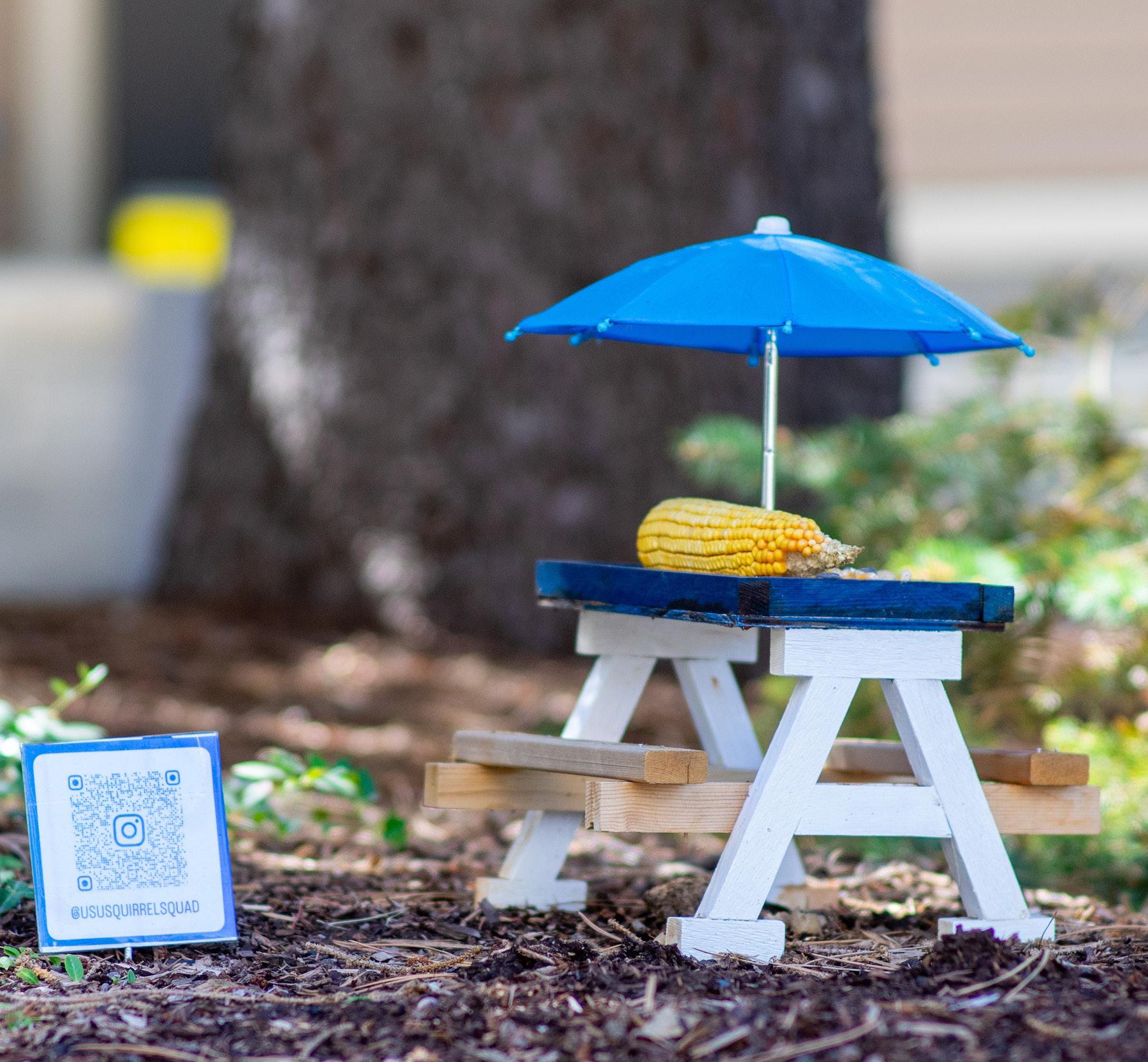
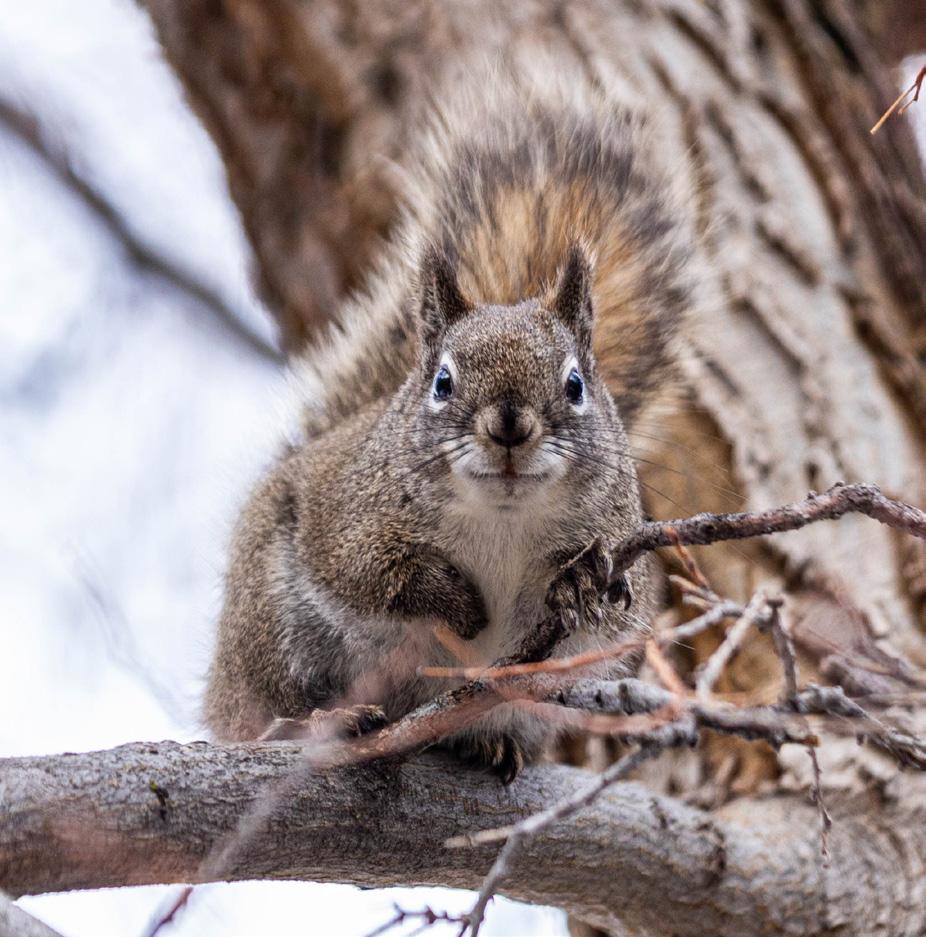
their first few weeks at USU,” they wrote. “That is what Aggie Family is all about and I am thrilled to add to that in a ‘small’ but adorable way.”
Despite missing tables, both Boudrero and the creator hope the project continues. The plan is to take the tables down when the snow comes and bring them back in the spring, much like the squirrels themselves.
The anonymous creator said each table takes careful effort. The first prototype took two weeks to build, but with templates in place, newer versions can be made in about a week. Scrap wood, nails, glue and paint form the structure while small umbrellas ordered online add a final flourish.
“I have a wood shop for my hobby project and was able to use scraps to build each table,” the creator wrote. “It really is as simple at cutting the pieces to the right lengths and angles, using nails and glue to fix them together, and then painting them Aggie True Blue and Fighting White.”
Since the project began, the creator said they have received dozens of messages from students saying how much the tables brightened their days.
“I have received sweet messages from students saying how much seeing the tables helped them feel welcomed and encouraged during
“I just think that these little tables really are just a showing of Aggie spirit and the joy that happens when we partner in community,” Boudrero said.
For now, the miniature picnic tables remain scattered across campus, landmarks that according to Boudrero, bring a bit of whimsy in wood and paint and remind students Aggie traditions sometimes start from the smallest acts of creativity.

Dylan Moore is a junior majoring in political science and minoring in anticipatory intelligence and Russian. He always loves going on outdoor adventures and cooking.
— dylan.moore@usu.edu
PHOTO BY Dane Johnson
A handmade miniature picnic table is seen outside near the Eccles Conference Center on Sept. 24.
PHOTO BY Jack Burton
A squirrel looks for nuts in a tree outside the Eccles Science Learning Center on Feb. 20.
William Holmes’ unlikely path to Utah State Football
By Carson Frost Statesman Senior Reporter
Utah State outside linebacker William Holmes isn’t supposed to be here, at least not in the conventional sense.
On Sept. 13 at Maverik Stadium, in just his 12th career game of organized football, the 24-year-old sophomore piled up a career-high 13 tackles and a fumble recovery in the Aggies’ 49-30 win against Air Force.
For a player who never played Pop Warner, never suited up in high school and spent the first half of his 20s grinding on minor league baseball fields, the breakout marked another step in one of college football’s most unusual journeys.
Holmes’ story begins in Detroit, where his mother made sure he and his brother Jaren stayed on courts and fields as often as possible. Jaren is now playing professional basketball in Great Britain, while William cycled through multiple sports before committing to baseball full-time as a teenager.
“That’s all my mother did — just have us in sports,” Holmes said. “Me and my brother both played. He was the one who played football when he was little, and I was always with baseball, basketball. Then when I started discovering baseball, I completely dropped basketball and just focused up. I can remember I was always on a baseball field just playing sports all day, day and night.”
That commitment paid off quickly. By around the age of 15, Holmes was working with trainer Joe Neal at 2SP Sports Performance, a facility based outside Detroit. Neal said their relationship started rocky.
“I don’t think he was super bought in,” Neal said. “He was long, lean and lanky. He had some muscle, the frame and the general ability to jump out of a silo and
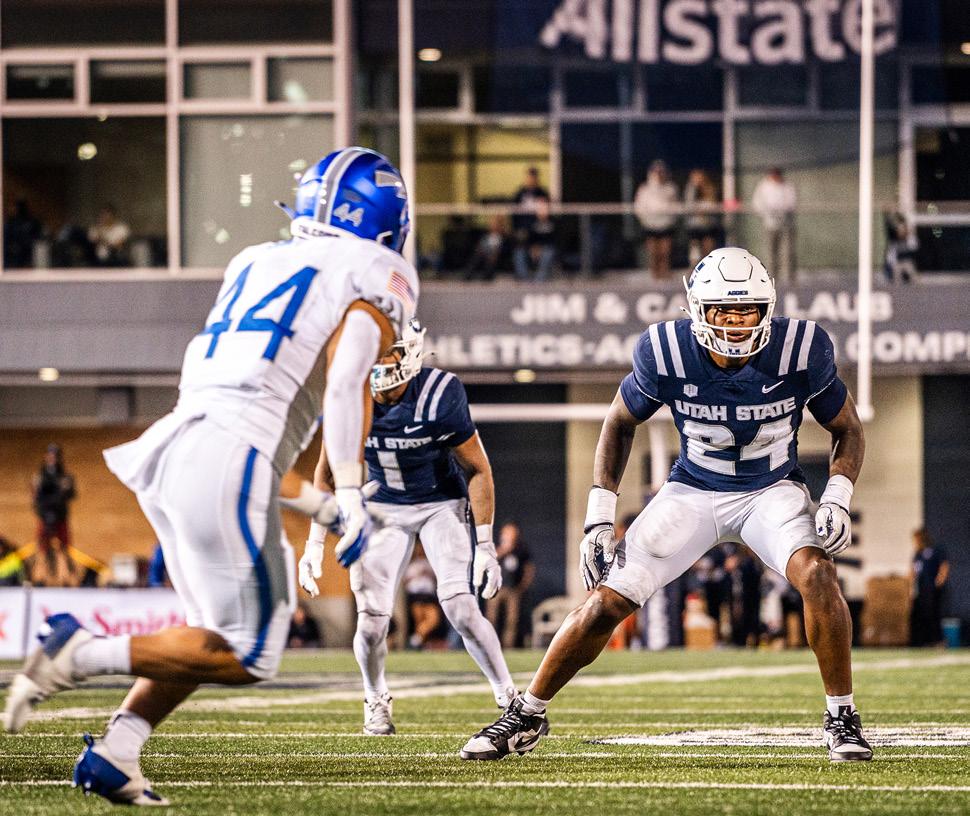
just the makeup and the pedigree was there. We had a meeting with him and his family, and I was like, ‘Look, man, I am on board with what you got going on, but you got to put in more work.’ To his credit, he did.”
Holmes’ natural tools stood out to Neal immediately, who has worked with some of the most prolific athletes across the country.
“I’ve trained hundreds of athletes, from MLB All-Stars to professional hockey players to NBA guys,” Neal said.
“Will is top three in athletic ability of anyone I’ve ever trained. He could play any sport he wanted.”
In 2018, Holmes was drafted straight out of high school in the fifth round by the Los Angeles Angels. He signed for a reported $700,000 bonus as a two-way prospect, capable of pitching and playing the outfield. His fastball touched 95–96 mph, a weapon that placed him among the hardest throwers in his class. He reported to the Arizona rookie league, later appearing with the Orem Owlz and Inland Empire 66ers.
Holmes called baseball “a gift,” but the grind was difficult. He admitted mentally, the sport wore him down.
“I never had any physical struggles,” he said. “The power of the mind in baseball is so strong. I never struggled in baseball until 2020, and I didn’t know how to handle it. That’s why things had to come to an end. You live and you learn, and now I try to take real good care of my mind.”
Neal believes the Angels organization moved on too quickly.
“I felt like they didn’t give him the time of day,” he said. “He was throwing mid-to-high 90s, freakishly athletic, but development in pro baseball can be brutal. It happens even to first-rounders. With Will, the ability was there, but the timing and support weren’t.”
By July 2023, Holmes retired. He returned to Detroit, spending time traveling with his mom and watching football on TV. After years of seasons that stretched from spring training through August, followed by short winters filled with workouts, he finally had free time.
Within months, he called a contact he knew from his baseball spring training days in Arizona —someone who had connections at Utah State. The conversation was brief. Holmes said he wanted to play football. Days later, he was invited to walk on in Logan.
His first practice was jarring.
“My first time playing organized football was spring 2024,” Holmes said. “I got pancaked with no pads. It was a frustrating day. I called my mom afterward. But I stuck with it. We got better and better every day.”
The learning curve was steep. Holmes admitted frustration often got the better of him, and he considered transferring. He even briefly entered the portal, weighing a move to Arkansas State with a former assistant coach, but ultimately stayed.
“I was just looking for an opportunity,” Holmes said. “Coach [Derrick Nsubuga] gave me an opportunity,
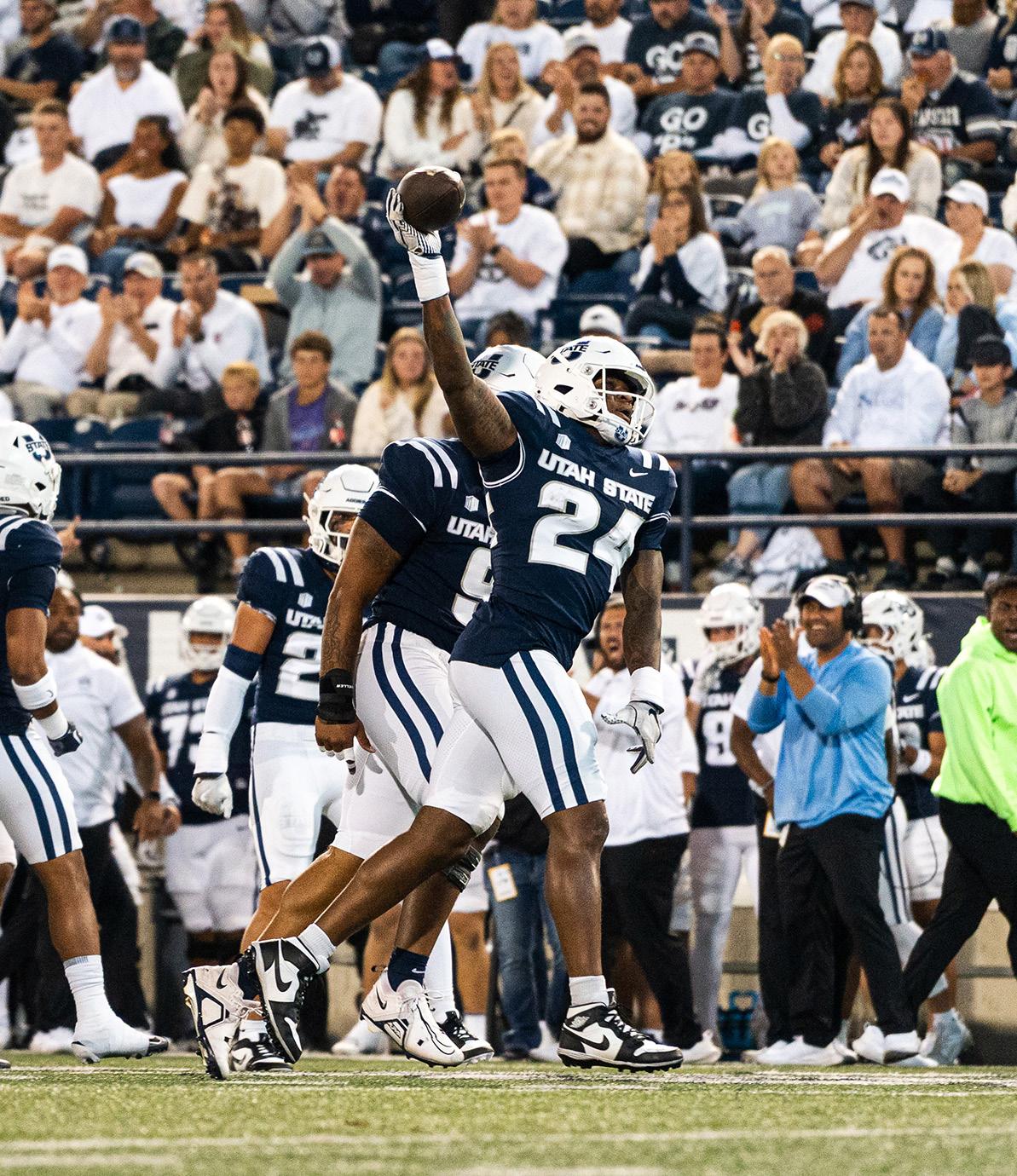
and I just ran with it. I love the culture we have now. I ended up sticking it out here, and it was a good choice.”
Utah State linebackers coach Jan Jorgensen had heard of Holmes before meeting him in person earlier this year.
“When we first got here, we kept hearing about a guy who just barely started playing — was really raw but really athletic,” Jorgensen said. “We watched film of the few snaps he played in 2024 and thought, ‘Dang, he doesn’t look like someone who hasn’t played before.’


Carson Frost is a transfer student studying journalism. His family originally hails from Los Angeles, and he is a passionate fan of the Lakers and Dodgers.
PHOTOS SUBMITTED BY USU Athletics
Utah State linebacker William Holmes, 24, plays in a game against Air Force on Sept. 13 at Maverik Stadium.
William Holmes, 24, celebrates after recovering a fumble during a game against Air Force on Sept. 13 at Maverik Stadium.
Utah State introduces new athletic director
By Carson Frost STATESMAN SENIOR REPORTER
Utah State University officially introduced Cameron Walker as its 13th athletic director this week, positioning him to lead the Aggies through one of the most significant moments in program history as the school prepares to join the restructured Pac-12 Conference in 2026.
Interim President Alan L. Smith said the hire comes after an extensive national search that drew an unusually competitive pool of candidates, bolstered by Utah State’s elevated profile following its conference move.
“We had an incredible pool of interested candidates nationally,” Smith said. “It was evident to us that at that level of talent, they’re not going to have trouble with any new president that comes in.”
Smith explained that the urgency of the Pac-12 transition outweighed the alternative of waiting until a permanent president was in place. He added that a new president is expected to be hired this fall.
“Two bites of the apple is better than one,” he said. “We thought, ‘Why not move ahead,’ especially given the urgency of our transition.”
“Compete and dominate”
Walker, who spent the past nine years alongside Tennessee athletics director Danny White at both Tennessee and UCF, used his introductory remarks to set an ambitious tone.
“There’s never been a time like this in college athletics, and there’s never been a time like this on Utah State’s campus,” Walker said. “With the imminent change to the Pac-12, we have to start sprinting now. It’s an exciting opportunity, but we want to be ready for it, not just ready to participate. It’s not a Pac-12 participation trophy. We want to compete, and we want to dominate.”
Walker laid out three core values he said would define the department under his leadership: student-athletes first, integrity and excellence.
“Winning without integrity at Utah State is not possible,” he said. “We will operate in full compliance, but we will hold ourselves to even higher standards.”
He promised athletes they will remain the top priority.
“When they put Utah State across their chest, they need to know that they have the full support of each and every one of us behind them,” Walker said.
NIL and resources
Walker acknowledged the shift from facilities to “talent acquisition” through NIL and revenue sharing. He brings extensive experience from his previous tenure at Tennessee in navigating that landscape.
“We have to be elite in that space, and you have to be elite in two areas,” he said. “First, you have to have enough to spend. Competition is going to be spending it. We’re going to have to go out and raise. But then we have to spend it wisely.”
Sandy Barbour, who has served as interim AD since July and will stay on through Oct. 6, said her focus was on building the right NIL infrastructure for the next leader.
“We were able to make some good progress — not necessarily in resource acquisition but in making sure that we had the organization and the structure right for this institution to be able to participate in that in a way that protected students, protected the institution, the department,” she said. “Now the big next step is resources.”
Addressing turmoil, building unity
Walker takes over at a time of transition and scrutiny for Utah State and its athletics program, with both internal challenges and external lawsuits tied to the Pac-12’s ongoing realignment. When asked how he would approach that backdrop, he said his role will be to unify.
“I think the biggest thing I can do is be a bridge builder moving forward,” Walker said. “Maybe that’s a better word — be a unifier. I wasn’t involved with the past. What I need to do is move forward. And we need everybody in order to move forward effectively.”
Smith agreed Walker’s temperament fits the moment.
“He’s got a pretty steady, mature demeanor,” Smith said. “He’s somebody who’s going to be thoughtful in approach and strategic in approach. A lot of what we’ve been trying to do as a university is to keep our eyes on the long horizon and make wise, strategic decisions. That’s the way you kind of have the fray off to the sides and you keep moving forward.”
Attendance and fan experience
Walker also addressed declining ticket revenues in some sports and record demand among student fans in others. USU Football has averaged 16,615 fans through its first three games at the 25,513-seat Maverik Stadium, while volleyball and soccer have already set attendance records this fall.
“We need this community to show up,” he said. “We need everybody here, and we need to make it an event that they want to come to. We’ve got some work to do on our side, and we’re going to have to ask them to come out and show up and be here and support us because it’s an incredible venue, but we’ve got to provide a situation where they want to be here.”
He added fans should expect more than just wins and losses.
“We’re in the entertainment business. It’s got to be entertaining. Win, lose or draw, people need to leave saying, ‘That was a good time,’” Walker said. “Some of my best experiences in life are at sporting events. They can be incredible memories to share with family and friends. We need to provide the environment to make that happen.”
Barbour echoed that sentiment.
“What will never change is that this is a place for great Aggies to gather,” she said. “We have to make sure that’s the feeling people have when they walk out of here.”
Football and scheduling
Football scheduling remains a challenge, especially as power conferences reduce nonconference availability. Walker said he plans to work closely with head coach Bronco Mendenhall and try to pull from his experience of working in larger conferences such as the SEC.
“We’ll put together a plan that puts us in the best position to both increase revenue as well as compete for championships,” Walker said. “If I need to put some pressure on some old friends to try and get some games, I’m happy to do that.”
He also stressed the importance of in-state rivalries across sports.
“I think it’s important for us to play in-state schools,” he said. “But I don’t want to play them — I want to beat them.”
Transition to the Pac-12
Barbour described Utah State’s move as unusual, contrasting it with her prior work on conference changes such as USC’s transition to the Big Ten.
“We’re moving to a conference that is still finishing up its media rights, still working on what kind of championships we want, what our broadcast requirements are,” she said.

— carson.frost@usu.edu
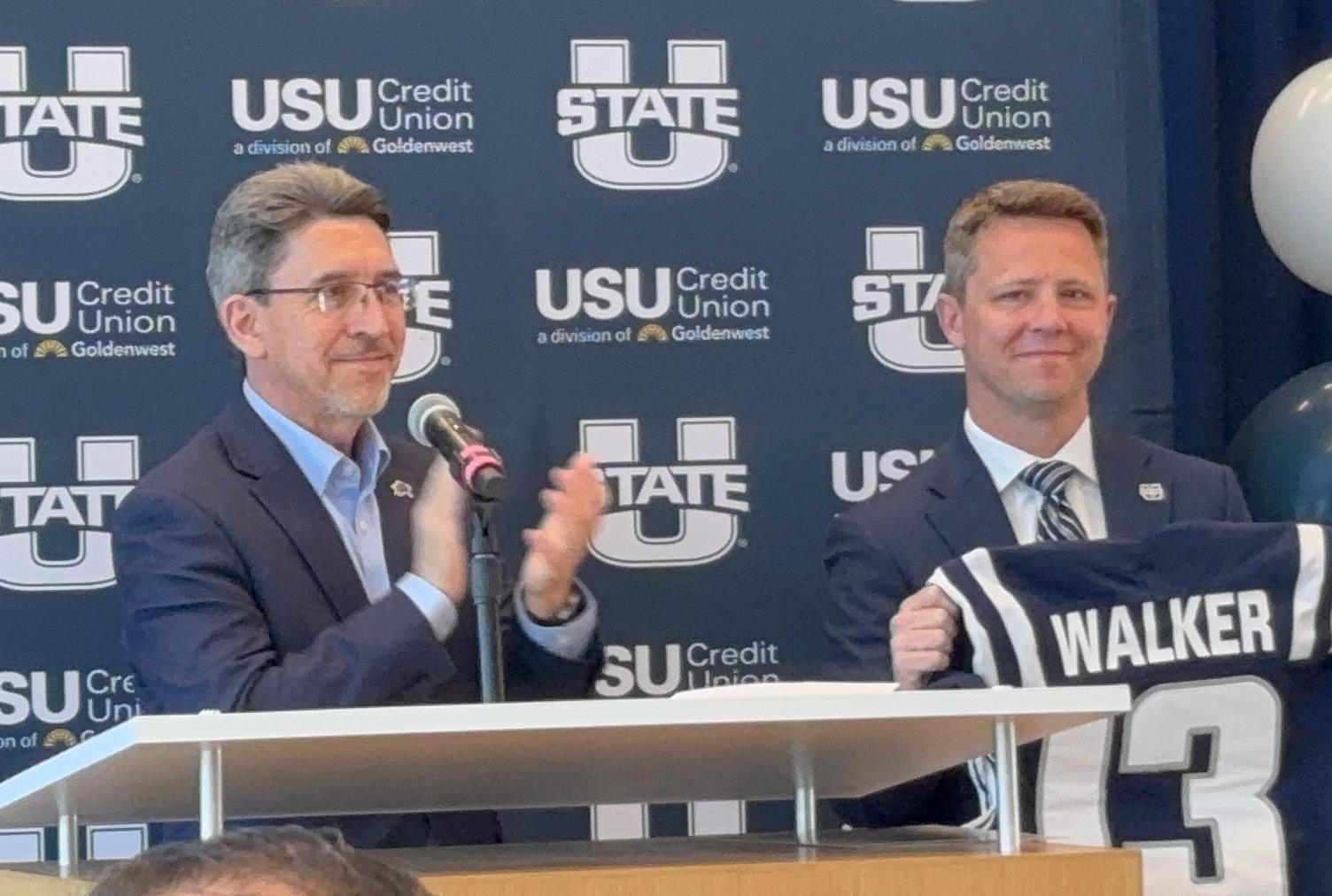
PHOTO BY Mark Greenwood
The new Utah State athletic director Cameron Walker, right, is introduced by interim President Alan L. Smith on Sept. 24 at the West Stadium Center at Maverik Stadium.
Club golf team coming to Utah State University
By Alici Archibald Statesman Reporter
The Utah State University Club Sports Program added a new club to their official roster: a golf club open to all students.
The recently-created club is looking for both men and women wanting to join a golf-centered community and compete. It doesn’t matter if those interested are novices or professionals, this club is a place to play, improve and enjoy the game together.
Braylen Carlson is the president and organizer of the golf club. She said she considered starting the club when she was approached about starting a competitive basketball club. Carlson said she knew she wouldn’t be interested in basketball but would consider golf.
Carlson started the process, and with the help of golfers Hunter Day and Andrew Bassett, it became an official club.
Carlson has played golf since her sophomore year of high school. She said she loves everything about the game but especially loves the competitiveness and variety it offers.
“Going to all sorts of different courses and never encountering the same situation twice gives an addictive challenge,”
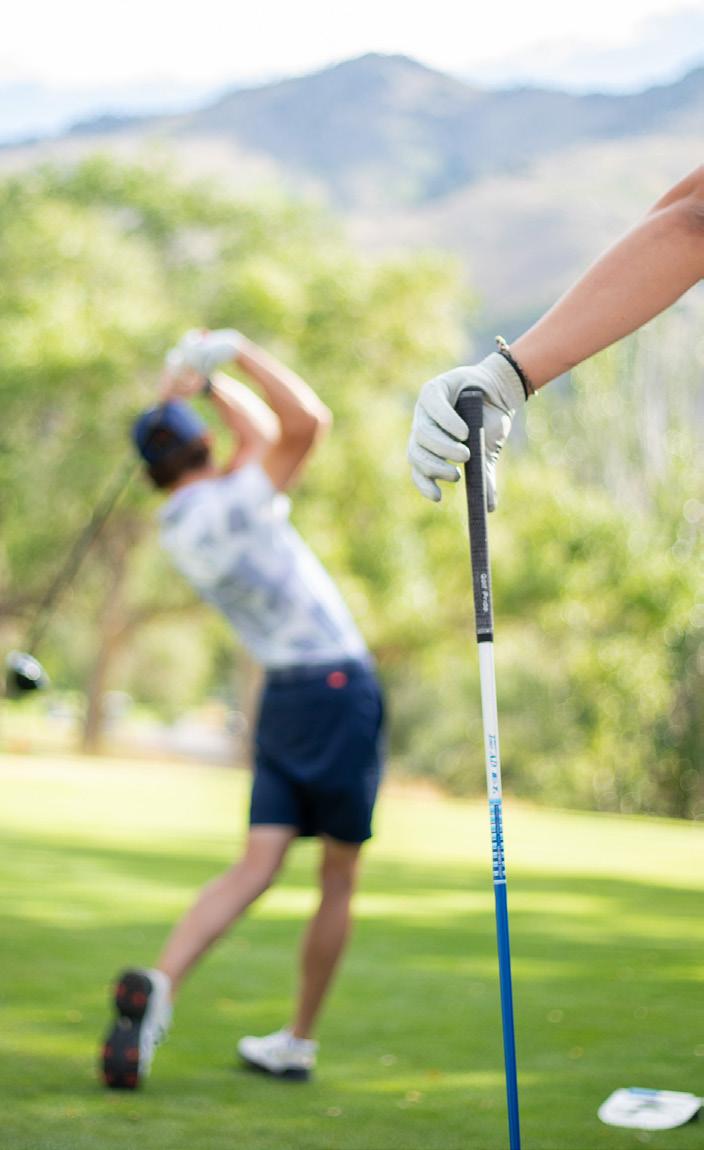
Carlson wrote in an email to The Utah Statesman. “Golf courses are so beautiful and offer amazing places to build relationships with people.”
Ellie Billings is an executive officer of the club. She’s played golf for most of her life, thanks in part to her dad and his love of the sport.
Billings also played competitively at Southern Virginia University, which she said grew her love for golf even more.
“I love golf because it’s challenging,”
Billings wrote in an email to the Statesman. “It’s a very mental game and requires a lot of patience. I like a good challenge, and it’s a sport you’ll be able to play for a lifetime.”
The club will be part of the National Collegiate Club Golf Association. They will play in the NCCGA regional tournaments and compete with other schools in the organization, including the University of Utah and Boise State University.
While they are currently still in the recruiting process, Carlson said she thinks they have 8–10 members committed but that they are surely growing.
“We really want to get the word out because there are so many other people that we know would want to get involved but just are unaware of it,” Carlson wrote.
While they don’t offer scholarships, the club is hoping to gain sponsors to make the cost of materials and competition cheaper for members.

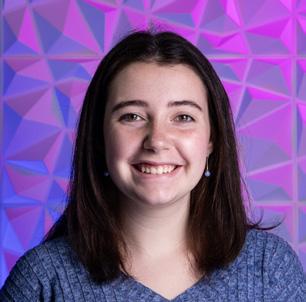
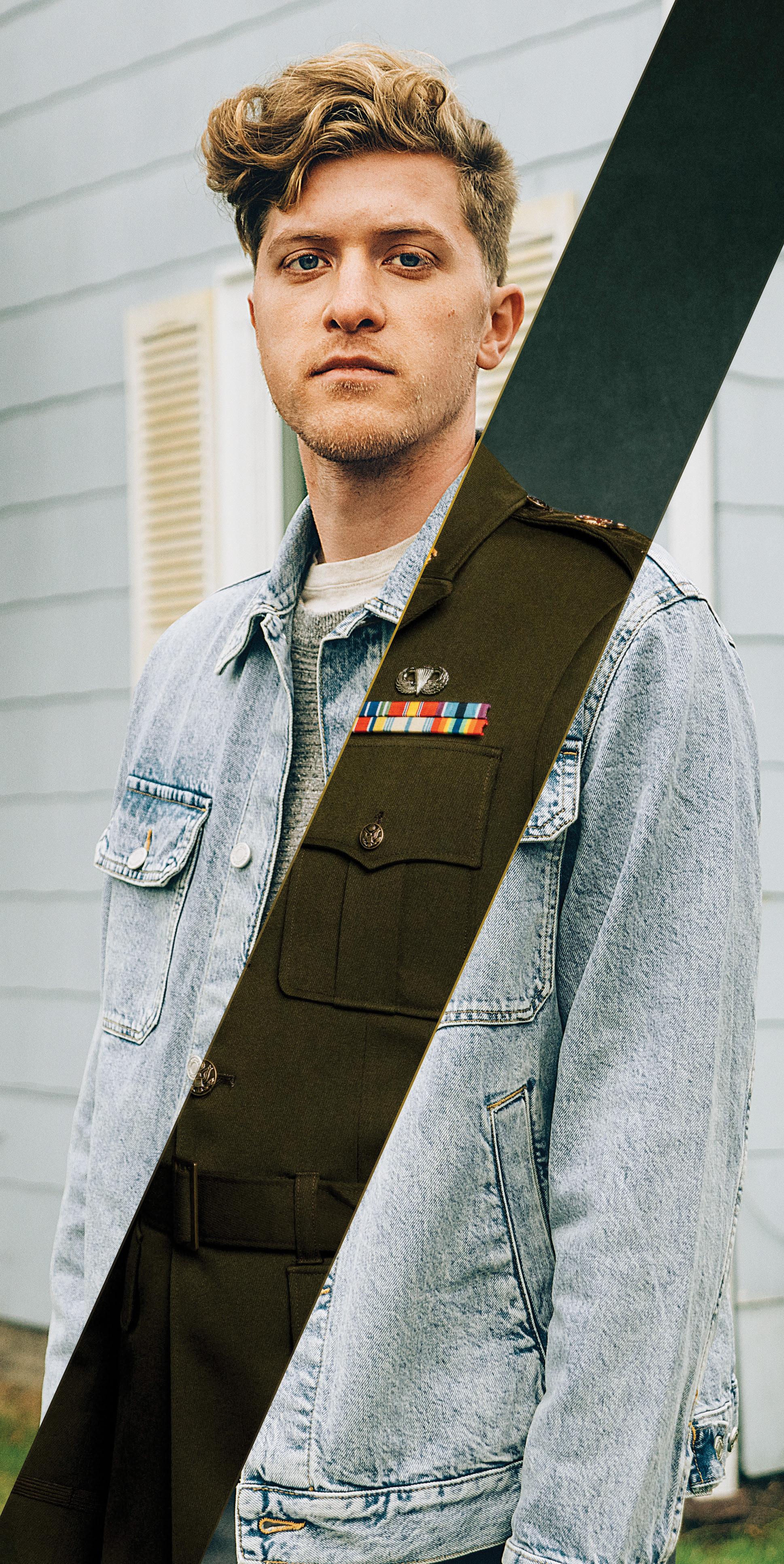
USU Men’s Rugby Club launches into 2025 season
By Alici Archibald Statesman Reporter
Utah State University’s Men’s Rugby Club kicked off its season on Sept. 13 with a win against Air Force, 40-29.
USU’s club team plays under the Collegiate Rugby Association of America, the highest level a Division I college team can play in. They are self-funded, player-led and coach-supported. Their program is financially run by the players and fundraising opportunities.
There are currently 38 players registered with the team, and head coach Matt Tualamali’i said there are more to come. He said this gives the team room to develop and grow with the sport.
Tualamali’i said he is excited to see what they can do this season.
Burton also played in high school and said he fell in love with the sport when he started in his junior year.
“Rugby’s the best,” Burton said. “I really love the guys on the team. You develop a really close bond. You spend a lot of time together doing things that kind of suck, and so you form a special bond together, and it’s a lot of fun.”
Matt Gatherum, vice-captain of the team, highlighted the club’s positive environment.
“I just love the atmosphere. Everybody’s out here to win,” Gatherum said. “Everybody’s out here to compete. It’s a brotherhood.”
Unlike Burton, Gatherum did not play in high school but started at USU. He joined because his brother played and invited him to join as well.
“I fell in love with it,” he said.
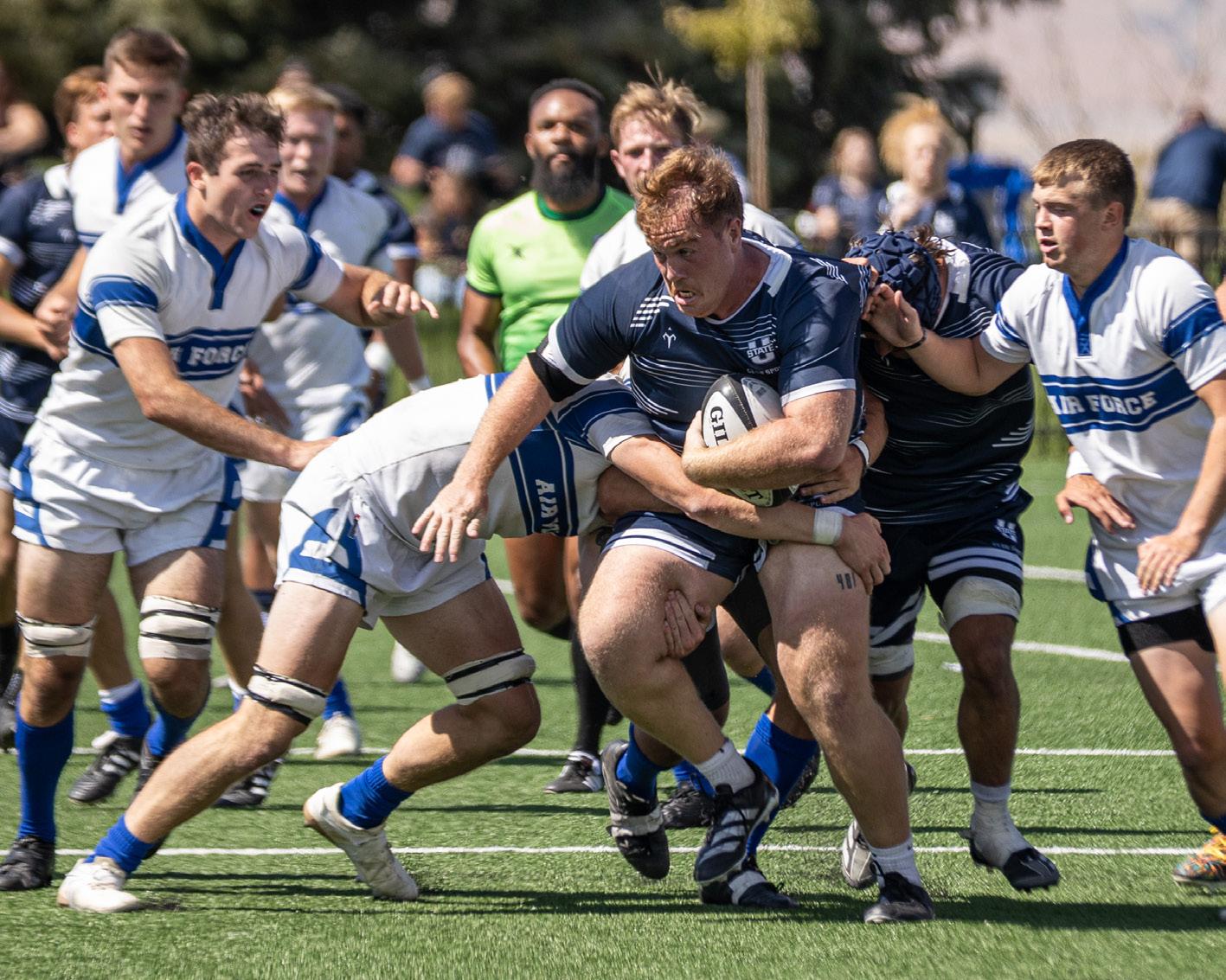
“Last year was the first successful winning season we’ve had here at Utah State,” he said. “I want to continue to build on that foundation we’ve created and to see how well Utah State flourishes here in the future.”
Team captain Jacob Burton agrees.
“I think the energy and the excitement is on a new level,” he said. “I think we’re excited on where we can go this year and get a little better every day.”
This is Burton’s third year playing rugby for USU and second serving as captain. He said he started helping out the team captains his first year on the team and when they left, they asked him to step up.
when a team grounds the ball in the opponent’s goal area, earning them five points. After scoring a try, the team can attempt a conversion by kicking the ball through the goal posts, which is worth two points. A penalty kick through a goal earns a team three points, as does a drop goal, which is when a player kicks for goal in open play.
The team has high hopes for the season.
“Practice has gone really good. We’ve all come prepared,” Gatherum said. “For our base structure right now, we’ve done really well in practice and we’re ready to go.”
The team will play their next opponent Idaho State University on Oct. 3 at the Aggie Legacy Fields.
“Practice has gone really well,” Tualamali’i said. “My hopes right now — I just want to see us succeed.”
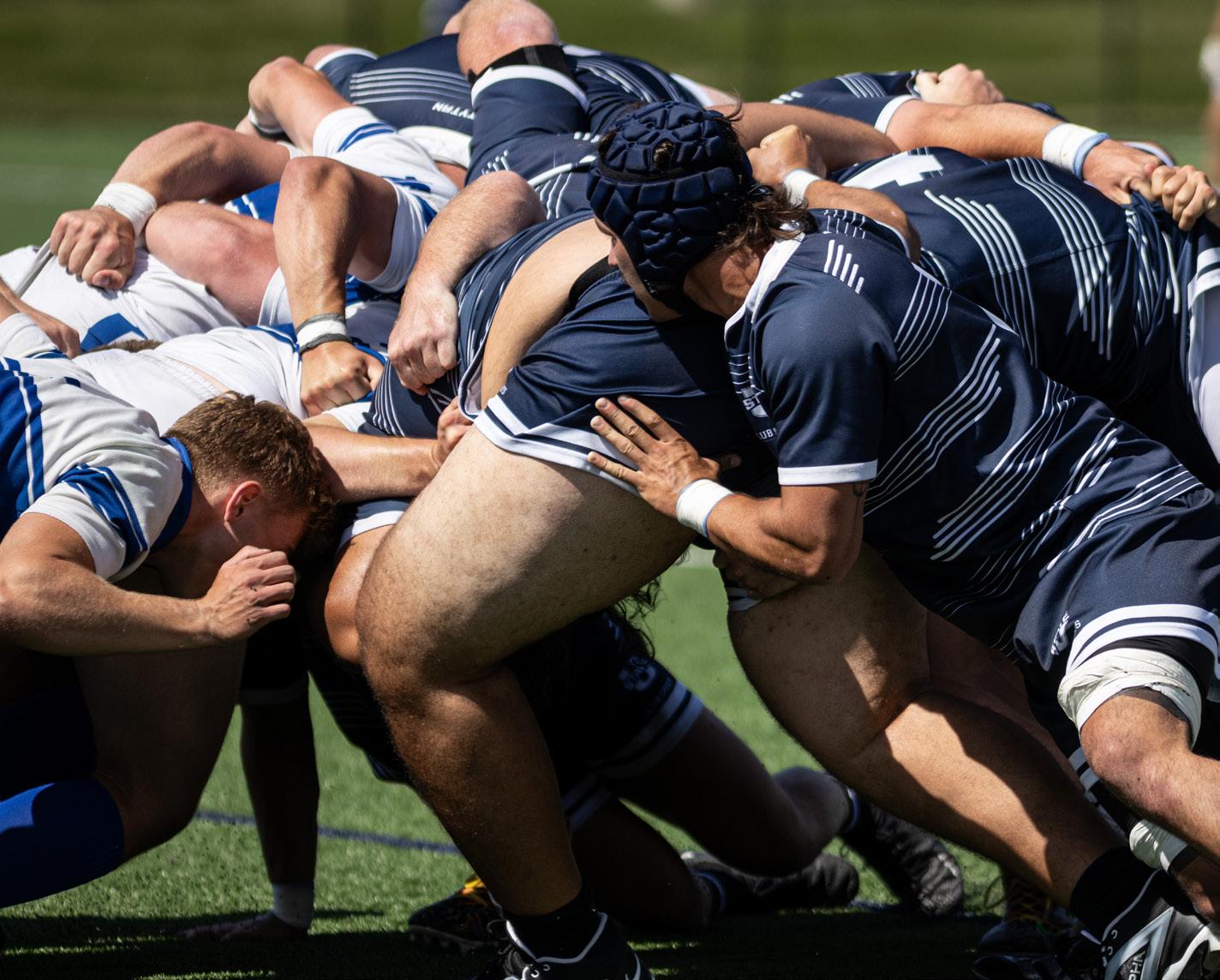
The team plays a version of rugby called 15s in the fall. The two teams each place 15 players on the field, and they score in a variety of different ways. A try is scored
PHOTOS BY Jack Burton
Franco Tellechea fights off multiple Air Force players at Aggie Legacy Fields on Sept. 13.
USU Men’s Rugby Club players battle Air Force in a scrum on Aggie Legacy Fields on Sept. 13.
Review: ‘The Summer I Turned Pretty,’ Gen Z’s love triangle
By Hazel Harris-Staples and Ella Stott STATESMAN EDITORS
Team Conrad or Team Jeremiah? It’s the ageold question — well, it entered mainstream media in 2021 when the first season of the TV show “The Summer I Turned Pretty” came out. Now, four years later, we have just seen the ending of season three, where that question was answered. At least, main character and love-triangle point Belly Conklin finally made up her mind after flip-flopping between two brothers, and we could not be happier about her choice.
You read that right: brothers. We’re not quite sure why this trope has become so popular — see “My Life With the Walter Boys” by Ali Novak — but we’ll tell you this: It’s entertaining. We are entertained. If you don’t want spoilers for the highly-anticipated finale of the most-talked-about show of the summer, look away. “The Summer I turned Pretty” is based on the book series by the same name written by Jenny Han. Each season corresponded with one of the books with just enough twist that fans didn’t know exactly what to expect from each episode. Honestly though, the fact that some people wanted and expected Belly to end up with Jeremiah — Mr. “Belly, Cacao is the Bean It’s What Chocolate Is Made Of” — was a little bit alarming. From the second Conrad walked into the frame in season one, to Taylor Swift’s “Lover” no less, we have been captains of Team Connie Baby.
Speaking of season one, let’s talk about the show’s start. Belly, short for Isabel, goes with her family to a summer house on the beach in Massachusetts every year, where they stay with her mom’s best friend, Susannah. Susannah has two sons, and they’re both — uh, oh! — attractive and available.
Belly has had a crush on Conrad, the older brother, her entire life, but he’s acting off this summer, likely because he’s the only one that knows his mom’s cancer came back and that his dad cheated on his mom while she was going through chemo — eff that guy! Since Conrad is dealing with all that, and because he suffers the classic boy-love-interest-who-thinks-he-shouldhide-his-feeings-so-as-to-not-inconvience-anyone-butthis-is-the-inconvenience syndrome, Belly looks toward Jeremiah, who claims he has always loved her, even though he quite literally says that this summer — aka the one she “turned” pretty — was the first time her saw her in a romantic light. Coincidentally, it’s the same summer after he becomes a pyromaniac and lights a firework at his brother and Belly. It reminds us of when Hazel’s little brother lit gunpowder in his face the week of her wedding!
Conrad finally figures out his feelings and how to

communicate, at least a little bit, so Belly kisses him at the end of the season, leaving fans wondering what she’s going to tell Jeremiah, who she had already shared a few smooches with.
This is where Team Anti-Belly originated, the camp who hates Belly and thinks she should stay away from the brothers. Yes, there is some merit to this, but perhaps Belly deserves more grace than weird men on the internet are trying to give her. After all, they are teenagers, they all crave validation and they are all coping with fear and grief. People make mistakes.
And Belly’s mistake is named Jeremiah. In season two, one year later, we come to find out Belly and Conrad did date but broke up at Belly’s prom after Conrad refused to open up to her. His mom dies a few weeks later, leaving the summer house in the hands of her sister, who is extraordinarily eager to sell it. The entire crew returns to the beach to try and save the house, leading to awkward moments of Conrad and Belly post break-up and what some might think, and we completely non-understanding of, are “cute” moments between Belly and Jeremiah. We personally think it’s criminal to kiss your brother’s ex-girlfriend
— keep in mind, when Conrad kissed Belly in season one, he didn’t know she had kissed Jeremiah, and she and Jeremiah were also not in a relationship — on your brother’s car while his ex is wearing his sweatshirt and he is about to profess his still-present love for her.
Season two also gives us the magical “I thought you knew” beach scene, demonstrating the acting talents and range of Chris Briney, who plays Conrad, and Lola Tung, who plays Belly. Their commitment to understanding their characters and chemistry truly shines in every moment the two are on screen together.
Enter season three. This season starts with a fouryear time jump — not two like in the books — and shows Belly and Jeremiah get engaged only two days after she finds out that he sort of cheated on her by overhearing the news at a frat party. Jeremiah proposes standing up outside of a hospital. It’s giving lazy. If Belly was our friend, we would have told her it was a bad idea. Well, actually we did tell her — by screaming at the TV the Wednesday night that episode aired. Yes, he thought they were on a break, but she didn’t — it’s very Ross and Rachel core. Regardless of whether he cheated, her brother getting in a car accident scares Belly into thinking lifelong commitment is necessary, and the wedding plans quickly commence. Which is insane because Hazel has planned a wedding, and planning never quickly does anything.

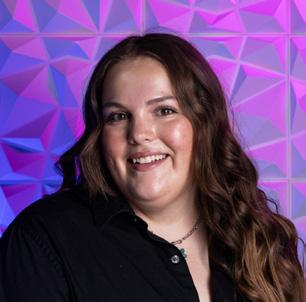

Hazel Harris-Staples and Ella Stott are the world’s best buddies and get to sit by each other in the Statesman office to the dismay of all of their coworkers.
— hazel.harris@usu.edu — ella.stott@usu.edu
“The Summer I Turned Pretty” poster taken from IMDb.
Up Close

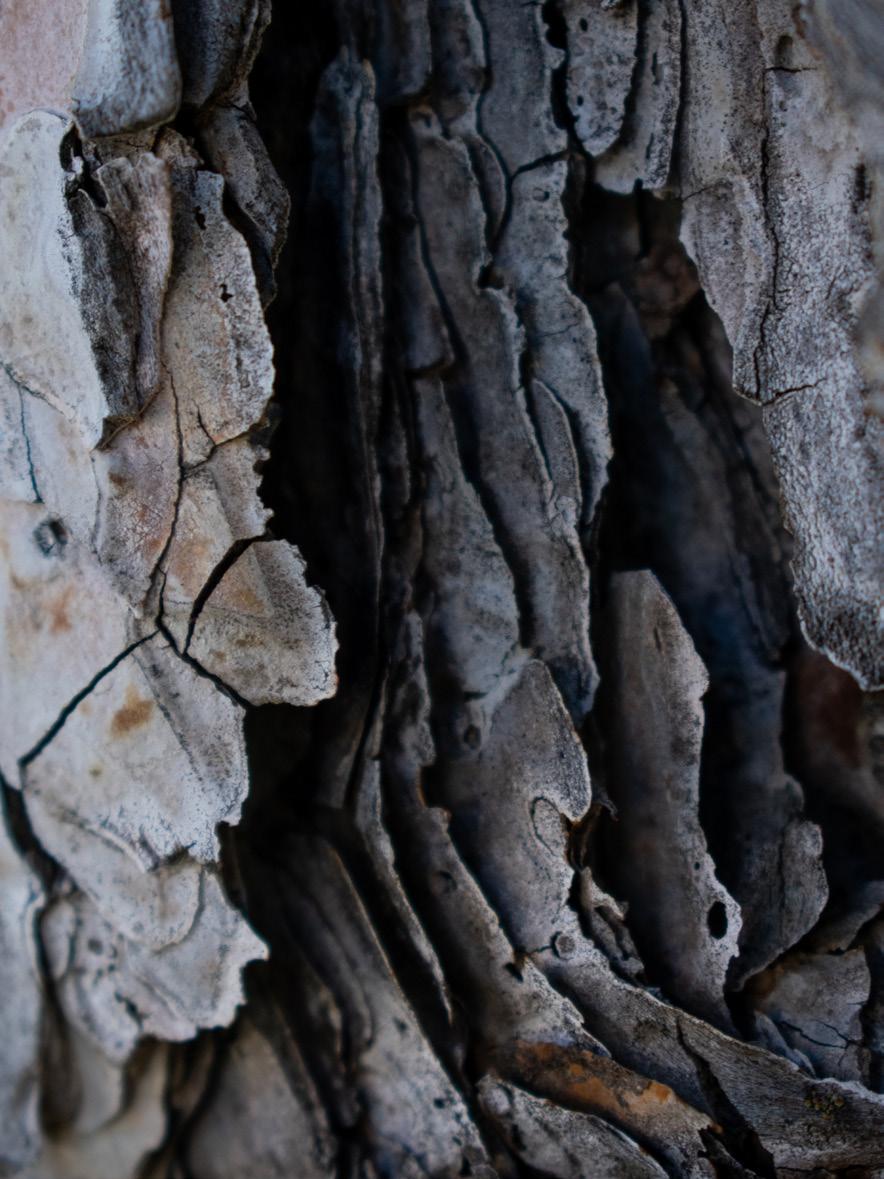

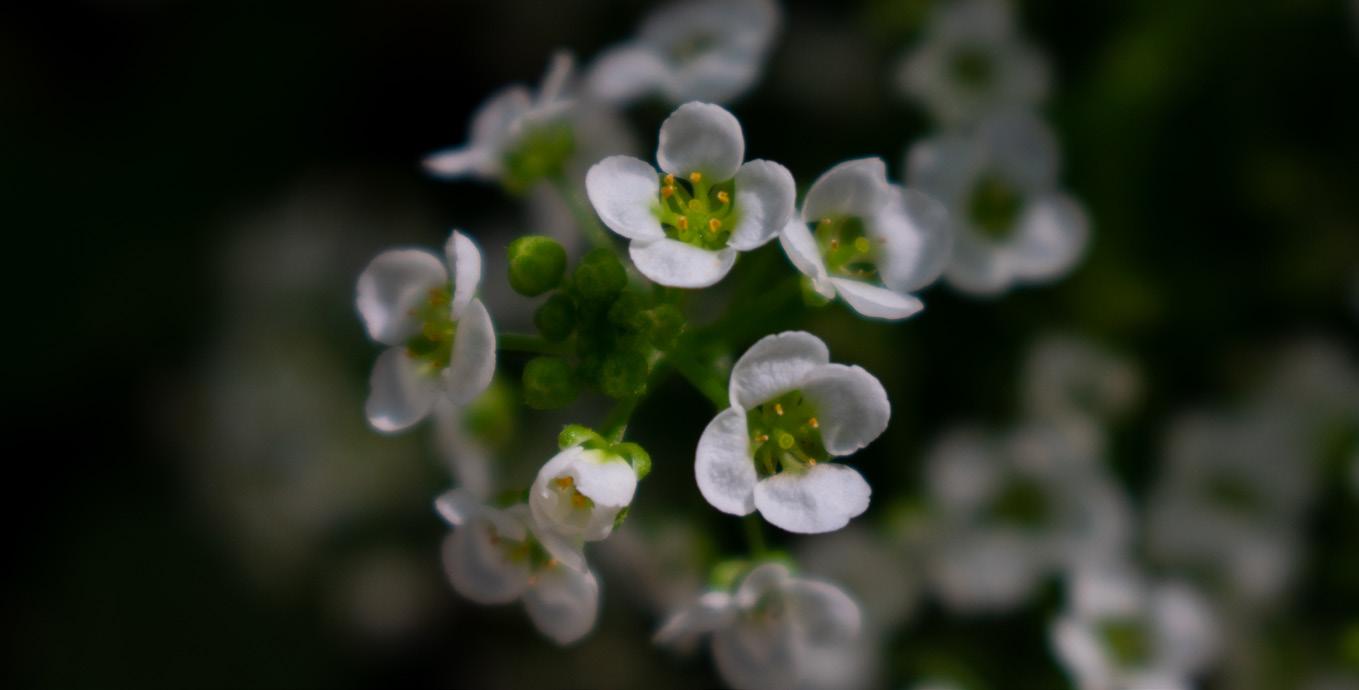
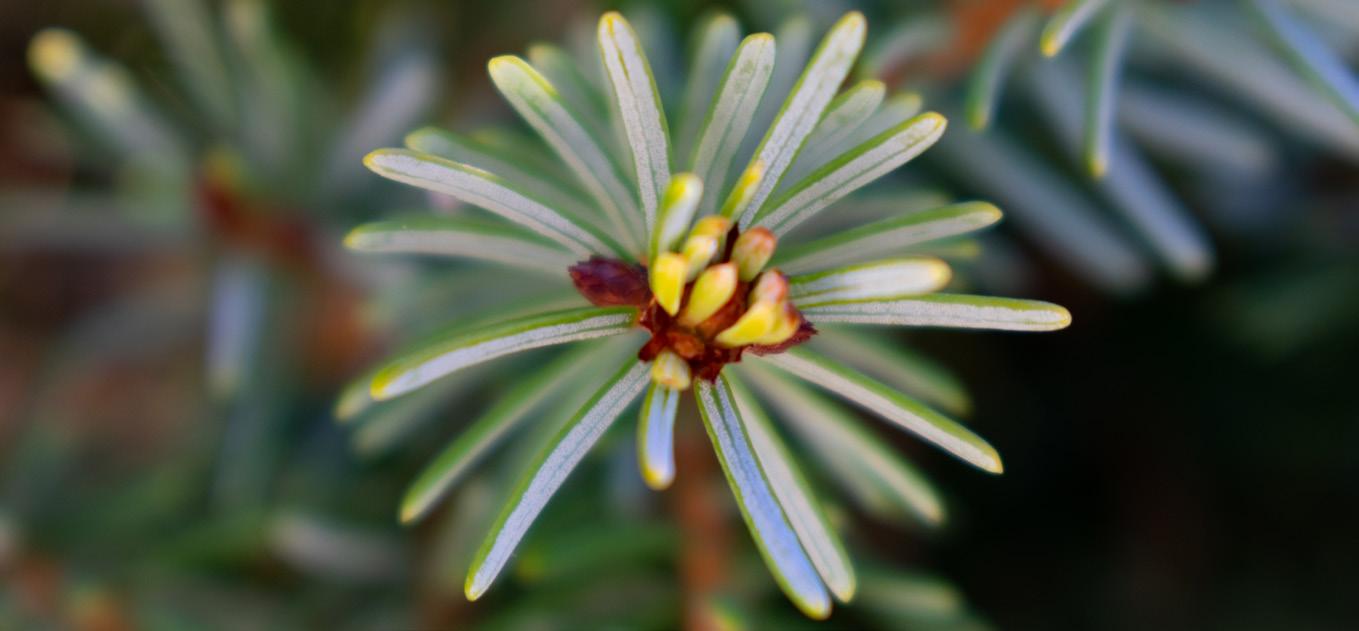



Elise Gottling is a sophomore studying outdoor product design who also loves being behind the camera. When she’s not taking photos, she can be found hiking, enjoying the outdoors or trying to amp up her guitar skills.
Chlorophyll

*Editor’s note: Letter to the Editor and Guest Column submission instructions are available at usustatesman.com.
By Thomas Grover
Governor Spencer Cox (Utah State ‘98) and Senator Mike Lee are slated to speak at the upcoming Sept. 30 Turning Point USA event at Utah State University. In the wake of Charlie Kirk’s assassination, America needs clear-eyed moral leadership to renounce political violence.
Governor Cox is obviously that kind of leader. One must ask, however, what Mike Lee adds to such an event. Will we see Senator Lee the public servant, or “Based Mike Lee,” who cracked jokes about the assassination of Minnesota House Speaker Melissa Hortman? Even after Senator Tina Smith tearfully begged him to stop normalizing political violence, he refused to apologize. He *still* hasn’t apologized. None of this is to say that Senator Lee, or his dark “based” internet alter ego, should be banned from speaking on campus. The First Amendment protects Senator Lee’s right to preen in cringeworthy hypocrisy, and our right to respond in disgust. This is a matter of accountability, not censorship.
At a time when America needs leaders to renounce war and proclaim peace, students deserve better than “Based Mike Lee.”
— tgrover435@gmail.com
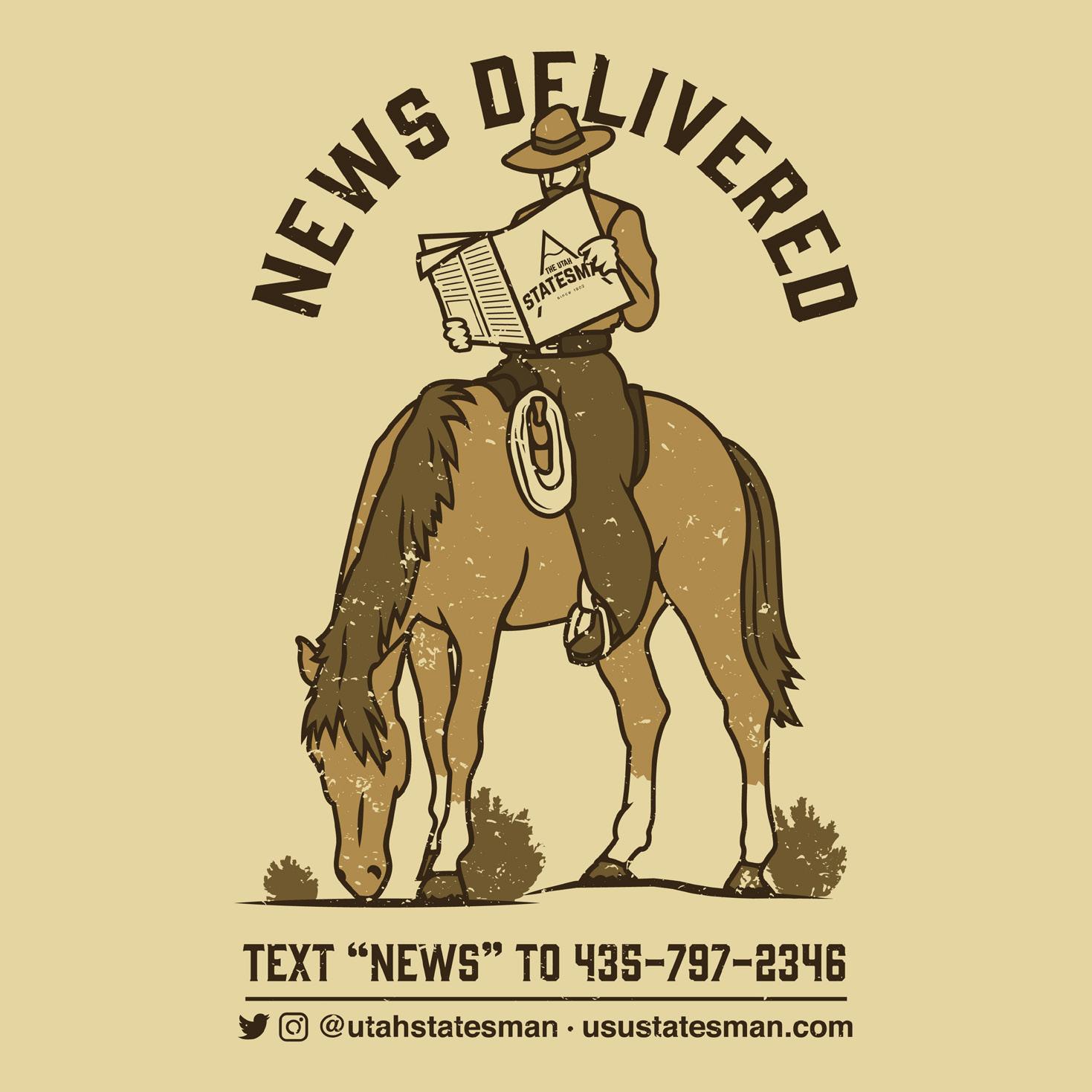

Last week’s solution:

Sudoku puzzles are provided by www.sudokuoftheday.com.



